Jean Miotte
Exhibition: March 6 – April 19, 2025
JEAN MIOTTE : TRAVELS BEYOND / A JOURNEY WITHIN
“True, great artists are those who have discovered their own path and followed it: they will be recognised and appreciated as such!”1
Jean Miotte
Some artists take the understanding of their art to the very furthest reaches. Jean Miotte pushed the experience of life very far. He did not just want to paint: he had to paint. Painting became essential to him, in order to live.
He traversed the self through the act of painting, with his sights set on a truth that, like a mirage, projected itself ever further away. This was how he travelled, towards a point that would bring him closer to the mystery of life. And this path, which took him on a journey within himself, also led him to the four corners of the world: to Syria, to the French cultural centre in Damascus, where he gave lectures; to the museum in Aleppo, where he exhibited his work; to China, where he was the first Western artist to be exhibited after the death of Mao Zedong; to Germany, where his second wife Dorothée Keeser, a great patron of his work, was from; and to the United States, where his foundation was based from 2002 to 2013.
What at first glance may appear to be a gestural style of painting, sometimes dazzling and incisive, sometimes trembling and delicate, is in fact the trace, or rather the testimony, of a continuous motion towards inner realms. Each work represents a step along the path of this journey, which is not theorised but lived through experience. A self-taught artist, Jean Miotte did not identify with any particular school – neither New York nor Paris. He made his way alone, from one encounter to the next. He bounced along when opportunities arose as others may jump from stone to stone to cross a stream.
At the age of 19, while engaged in military service, Miotte caught tuberculosis. He was diagnosed with a cavity in his right lung “as big as a potato”2 and was given just three months to live. Miotte left the hospital and headed straight for the Côte d’Azur, to enjoy the sun for one last time. When he returned to Paris and paid a visit to his doctor, the cavity in his lung had shrunk to the size of a ten-cent coin dime.
“What on earth have you been doing lately?” asked the astonished doctor.
“Nothing more than living as I please,” replied Miotte,3 before launching into an account of the extraordinary life that he had been leading.
For Miotte, life always prevailed over death, pulsing and gushing over his canvases, chasing away the shadows to make way for light.
In 1961, Miotte was awarded the Ford Foundation Prize and America opened its doors to him. First New York and then the Far West, with its wide open spaces and canyons, presented themselves to him. Contemplative and solitary, he explored them. His paintings bear no resemblance to those of Jackson Pollock or any other American. But his soul no doubt needed to come into contact with those landscapes to reach its fullest intensity and expression.
1 – Jean-Clarence Lambert, Visite à Jean Miotte, Paris, Éditions Caractères, 2002, p.55
2 – Jean Miotte, L’Élan dans le défi, Saint-Julien-Molin-Molette, Les Sept Collines – Jean-Pierre Huguet Éditeur, 2001
3 – ibid, p.24
Born in the north of France, Jean Miotte was more attuned to Brueghel and Memling than to Botticelli, but his rigour and mastery were underpinned by an unbridled freedom that the North American continent provided him with an opportunity to explore.
Before America, there was Russian ballet, choreography and jazz – an intuitive quest for vibration, rhythm and, everywhere, dancing lines. “Movement is my life,” he confided 4. Jean Miotte never abandoned what he had encountered and been influenced by. A continuous form of motion enabled him to assimilate each experience to the extent that it transformed him.
On the linen canvases, whose hue evokes the tanned skins of the East, the black brush allows shapes to emerge, like silhouettes, sometimes undulating, sometimes bursting forth. Life pulsates and escapes. Is this the birth of a form of script? The canvases take flight. I have the impression that, through them, their creator is trying to uproot himself while at the same time anchoring himself in a world that belongs to him alone, of which he is the sole creator, but that by projecting it onto the canvas in such a way, he would like to share the dream of an open space, without boundaries. Marguerite Yourcenar concluded her account as follows: “… and the painter Wang-Fô and his disciple Ling vanished forever on the jade-blue sea that Wang-Fo had just created.”5 The painter and his disciple had entered the painting. At its most intense, Miotte’s gesture, his trace on the canvas, raises the question: is it possible to enter the painting? Can the painting take the place of the world?
Some may compare the artist’s black brushstrokes with Chinese and East Asian calligraphy. Twenty years after his time in the United States, in the early 1980s, Jean Miotte discovered Beijing, China and then nearly the whole of Asia.
Miotte followed his own path in an inverse trajectory to that of the sun. He never set, on the contrary; he was always rising, moving towards that mystical East from which all life springs, the very source of desire. Was that why he painted at night?
As Jean Miotte understood, abstraction in the twentieth century was never concerned with distinguishing itself from representation, much less with seeking freedom from the senses through arbitrary geometric forms. Abstract art involved a subtle process that the painter would choose to approach in a very perceptive and concrete way, by developing the Dionysian gesture recognised by Jean-Clarence Lambert.6
4 – Cité par Serge Lenczner, La permanence et l’absolu, New York, Chelsea Art Museum, 2006, p.16
5 – Marguerite Yourcenar, Nouvelles Orientales, « Comment Wang-Fô fut sauvé », 1963, Paris, Gallimard, Collection L’imaginaire, 2023, p.28
6 – “Et toi, au contraire, tu as rencontré ce que tu désignes dans une gouache comme le vertige : tu es définitivement passé du côté du dionysiaque.” [“And you, on the contrary, encountered what you depict in a gouache as vertigo: you have definitely crossed over to the Dionysian side.”] Jean Clarence Lambert, Visite à Jean Miotte, Paris, Éditions Caractères, 2002, p.25
Indeed, only he who seeks out his own East and returns can claim to bear witness to that presence, that is, to leave an authentic trace of the process of abstraction. Dionysus, Greek mythology tells us, was the god who came from the East. He symbolised the foreign divinity who, on his return to the city of Thebes, was no longer recognised. Dionysian work always bears witness to such a return, from the depths of oneself, into the field of the visible. It opens up a space-time experience to which the gaze must be initiated.
The abstract painter strives for a point of liberation and a projection into the origins of the world. More than an artist, they are a poet (which means, etymologically, creator) – and a player!
In this world of appearances, only those who play reveal themselves to be creators. One has to know how to combine depth and a play on surfaces, gravity and lightness. Jean Miotte threw himself into the adventure of his life, just as others throw the die on a gambling table. One could think that he was relying on chance. But his faith in the spirit was too strong for him not to abandon himself to it.
“For me, painting, like art in general, takes on a completely different dimension. It is first and foremost a commitment to being and not the execution of a paintingobject,” he acknowledged.7
Looking at his work, reading what he had written and what others had written about him and his work, I recognised in Jean Miotte an impassioned traveller. His life consisted of overcoming, through experience, his idealistic background in order to bring into existence a more ethical and poetic human reality. For him, aesthetics represented ethics. “The artist has nothing but their life for their art,” declared Jean Miotte.8
And this life force moves us through his canvases for the very reason that it leads the painter – and hence us too, the viewers of his paintings – to abandon ever more the comfort that might come from the slightest certainty of fitting in with this or that. To view one of Jean Miotte’s works is to decide to take leave of what we know about ourselves and to abandon all preconceived identities, all social conformity, and all psychological traits, in order to reach the meaning or the metaphysical motive that animates us and that is our responsibility, artistically, whatever our art, to bring to light and to life.
Each brushstroke left on the canvas proclaims: Dare! Dare to live, you who are human! Enter the world of your painting. Make your life a work of art. For that is the great, the only journey.
Camille Laura Villet
Essayist, PhD in philosophy
and psychoanalytic anthropology
7 – Jean Miotte, L’Élan dans le défi, Saint-Julien-Molin-Molette, Les Sept Collines – Jean-Pierre Huguet Éditeur, 2001, p.37
8 – Idem, p.55
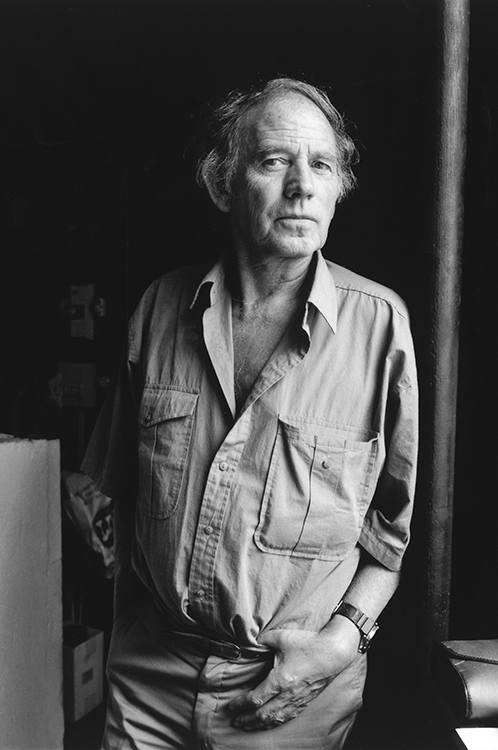
Jean Miotte, photo Philipp Hugues Bonan, 1992
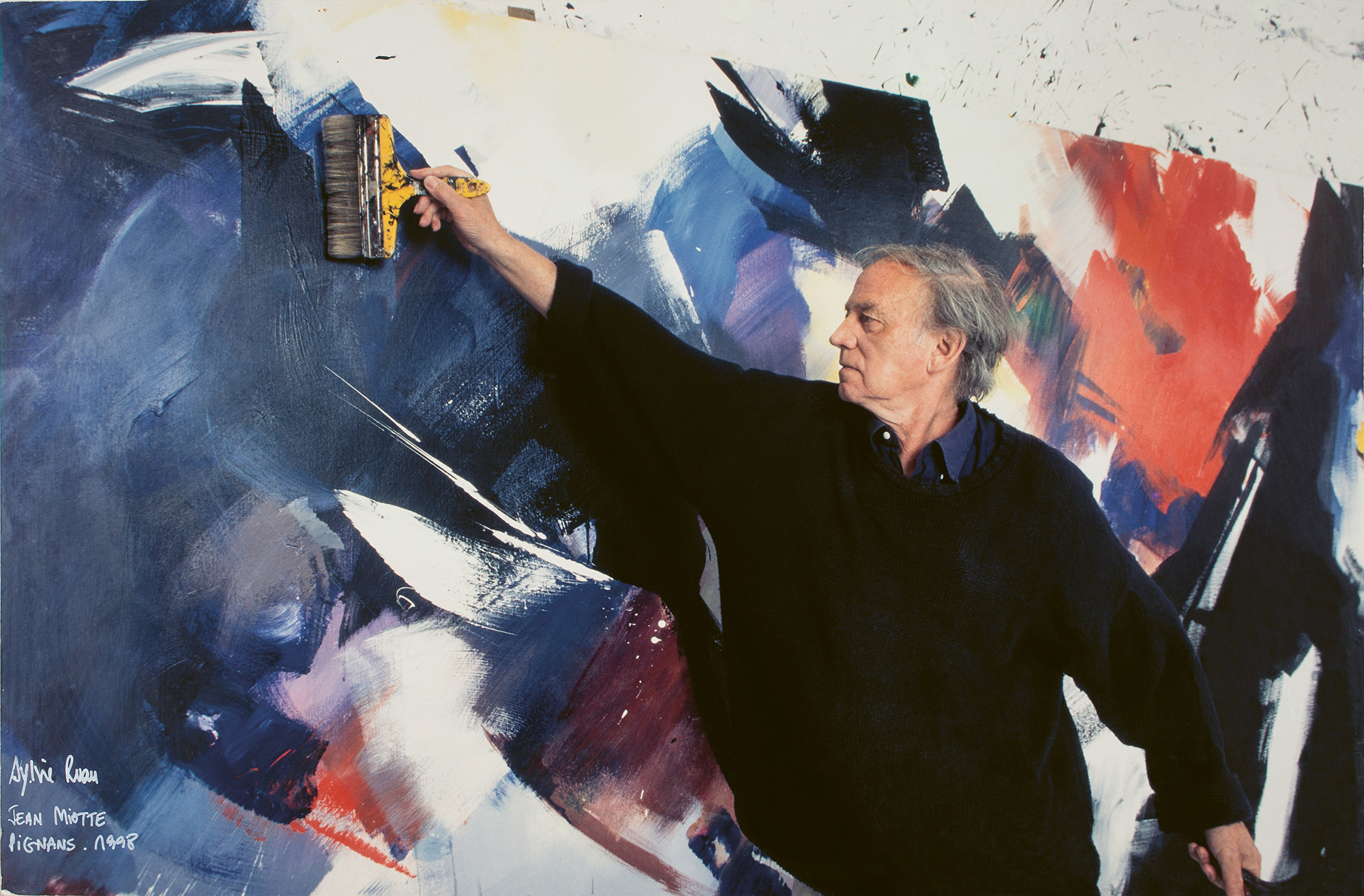
Jean Miotte, Pignans, France, 1998
Photo: Sylvie Ruau
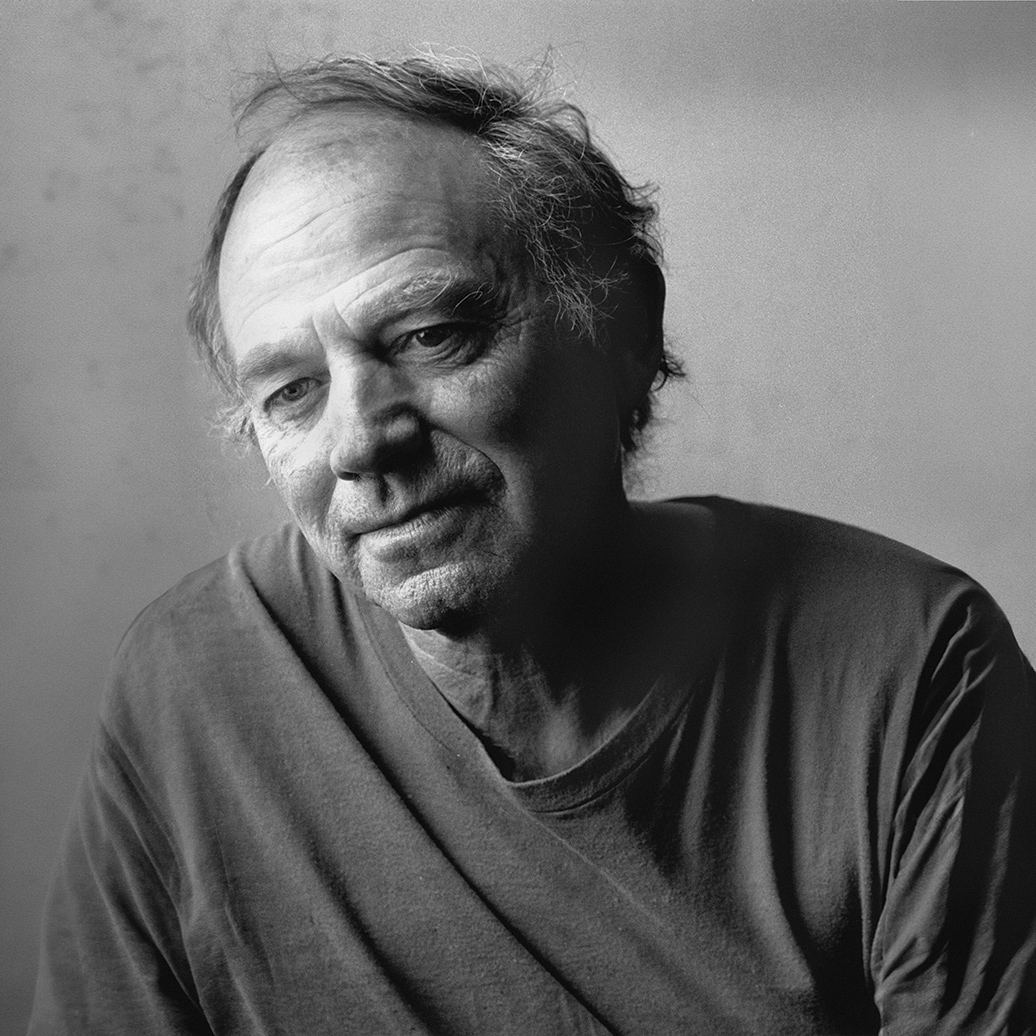
Jean Miotte, photo Philipp Hugues Bonan, 1988
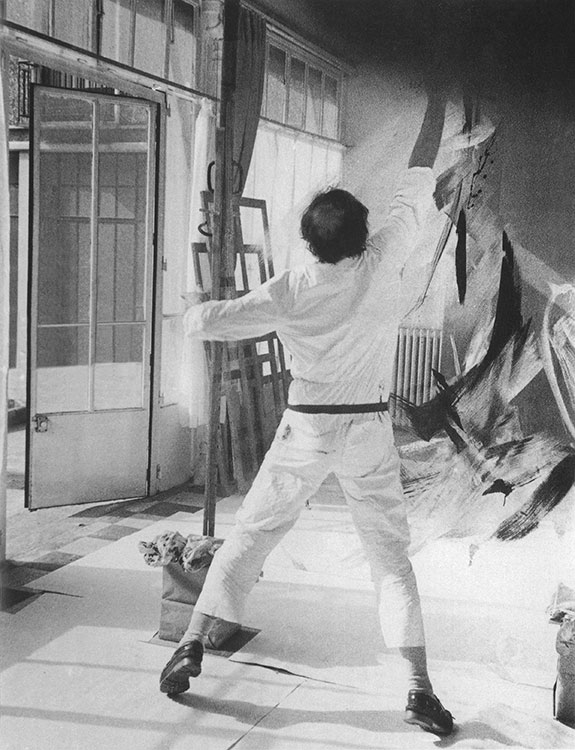
Jean Miotte in his studio during the realization of the movie du film Miotte, Espace Secret, Gérard Langevine, 1983
Œuvres exposées
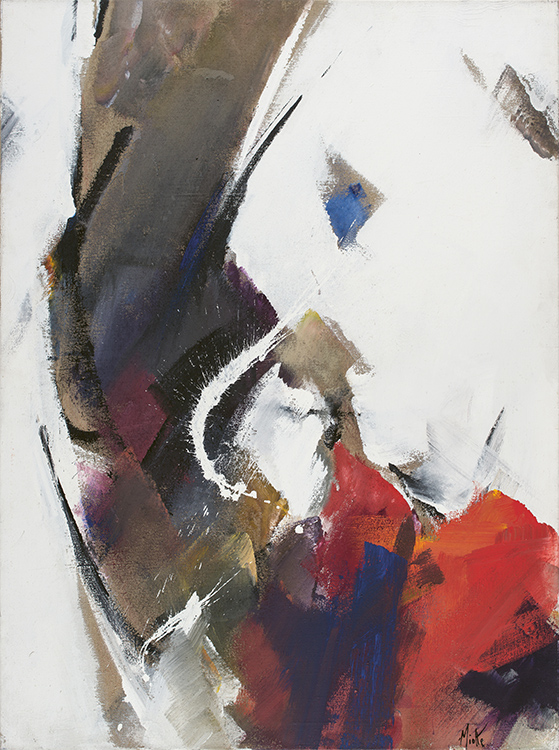
UNTITLED, c. 1970
Acrylic on canvas
130,5 x 97,5 cm / 51.4 x 38.4 in.
Signed “Miotte“ lower right
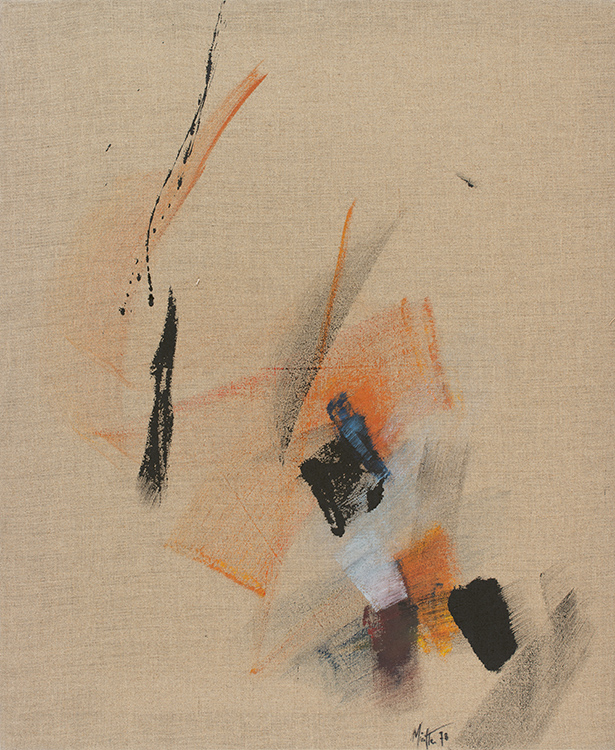
UNTITLED, 1978
Acrylic on canvas
81 x 65 cm / 31.9 x 25.6 in.
Signed and dated “Miotte 78“ lower right
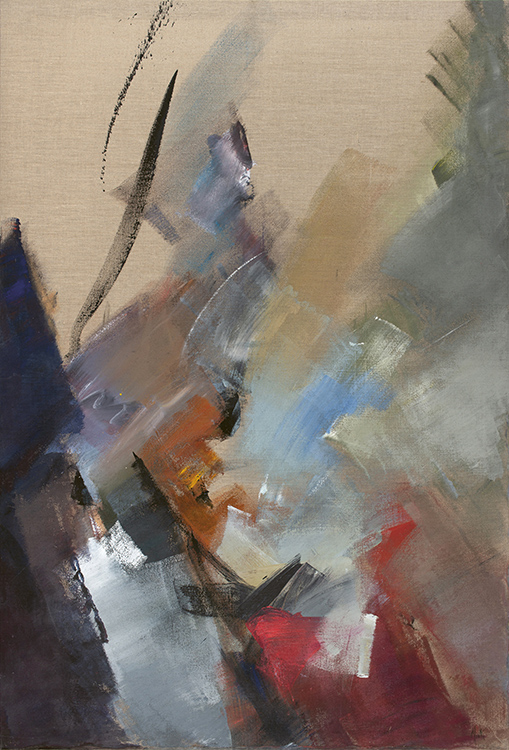
UNTITLED, 1978
Acrylic on canvas
195 x 130 cm / 76.8 x 51.2 in.
Signed “Miotte“ lower right
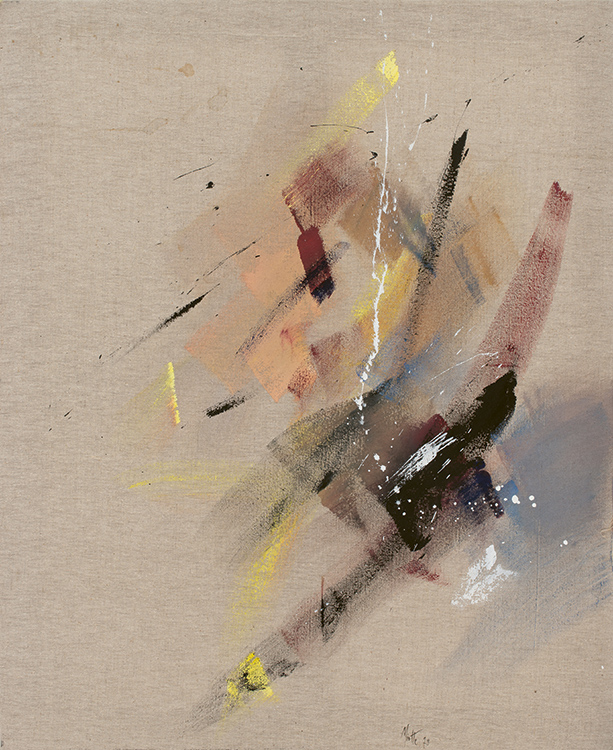
UNTITLED, 1978
Acrylic on canvas
100 x 81 cm / 39.4 x 31.9 in.
Signed and dated “Miotte 78“ lower right
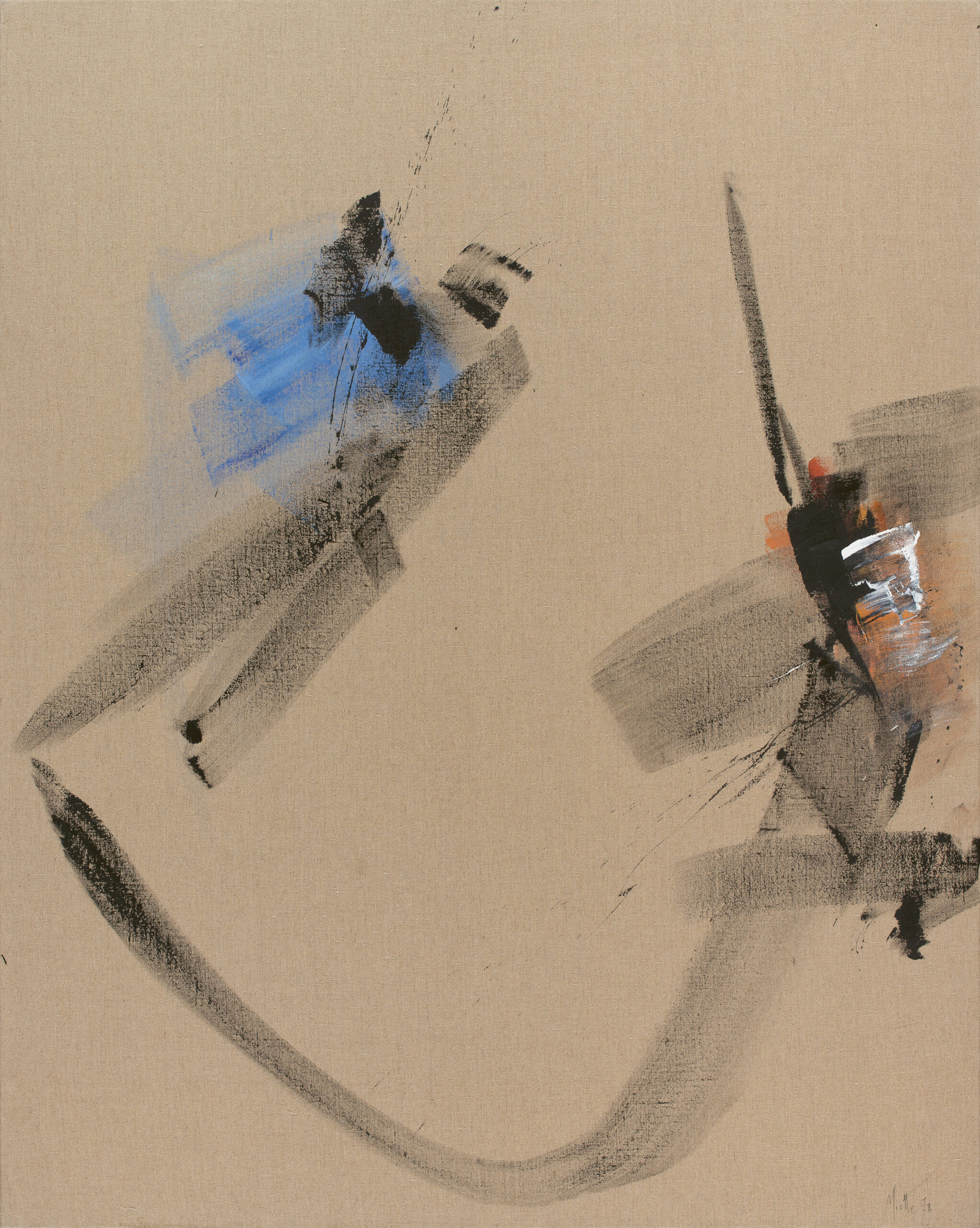
COLLOQUE, 1978
Acrylic on canvas
162 x 130 cm / 63.8 x 51.2 in.
Signed and dated “Miotte 78“ lower right
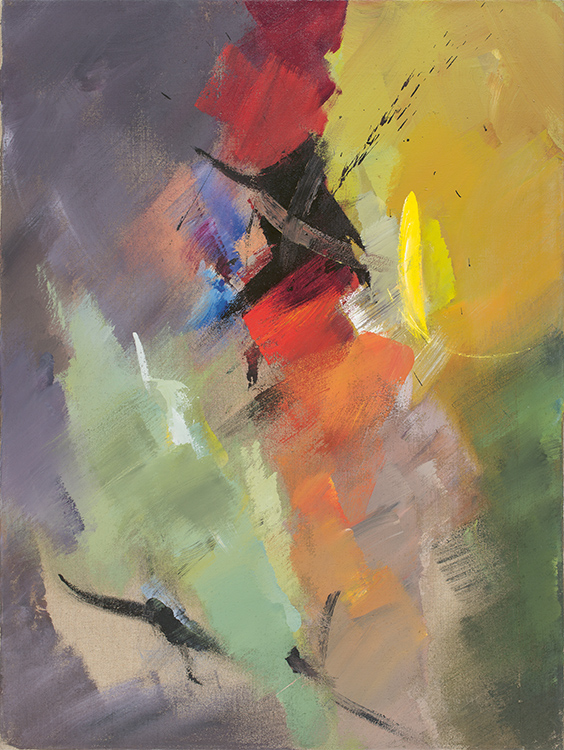
UNTITLED, c. 1980
Acrylic on canvas
97 x 73 cm / 38.2 x 28.7 in.
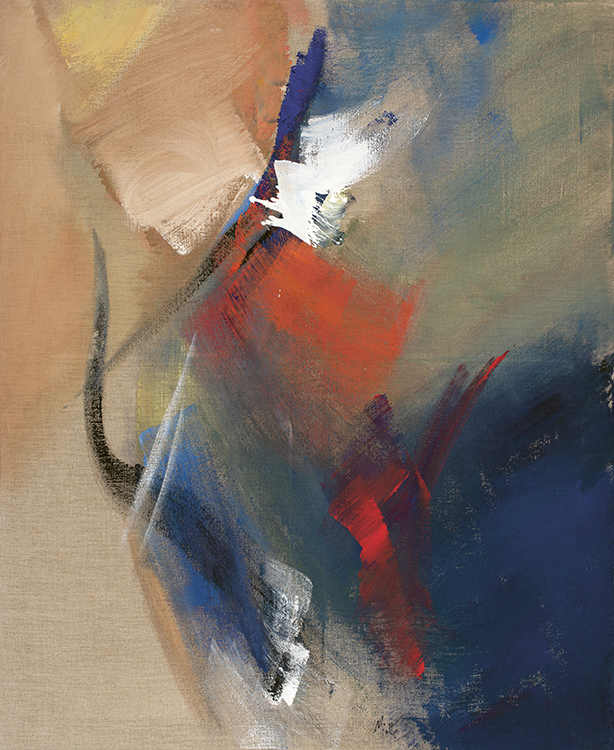
UNTITLED, c. 1980
Acrylic on canvas
100,5 x 81 cm / 39.6 x 31.9 in.
Signed “Miotte” lower right
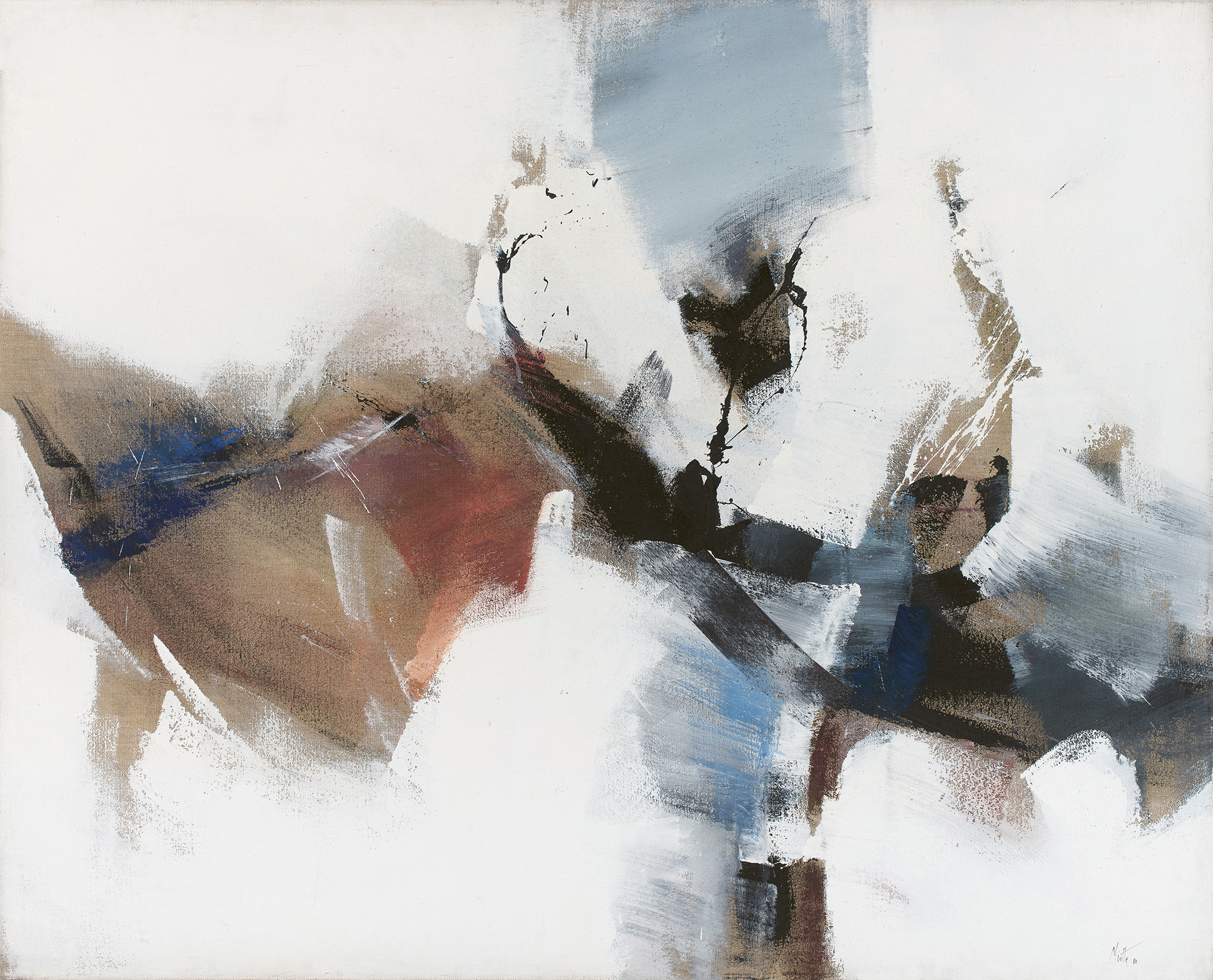
FUGUE, 1980
Acrylic on canvas
130 x 162 cm / 51.2 x 63.8 in.
Signed and dated “Miotte 80“ lower right
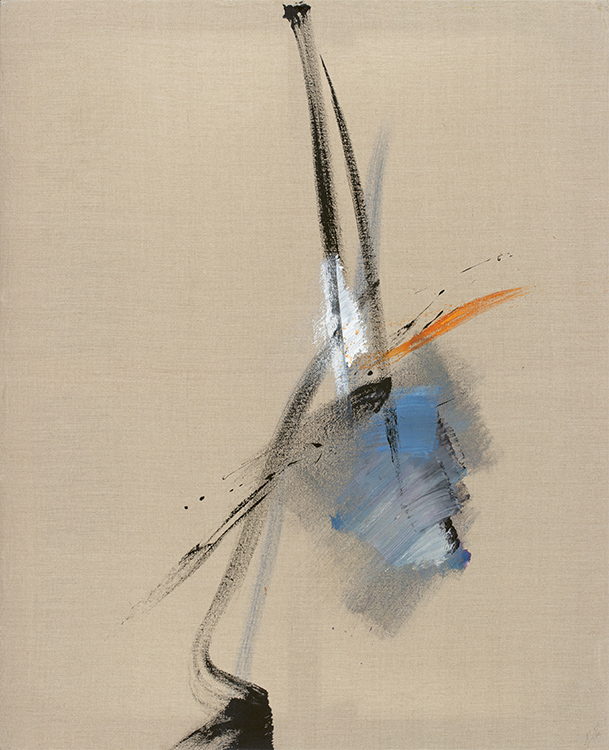
UNTITLED, c. 1980
Acrylic on canvas
100,5 x 82 cm / 39.6 x 32.3 in.
Signed “Miotte” lower right – Signed “Miotte” on reverse
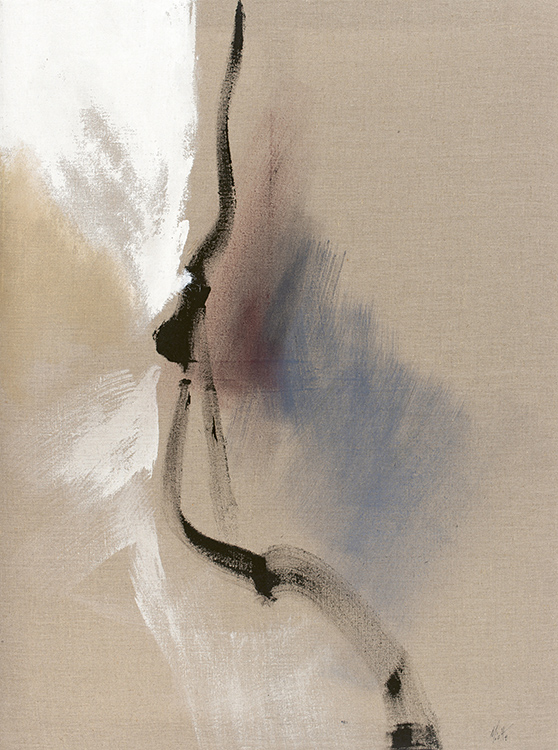
UNTITLED, c. 1980
Acrylic on canvas
130 x 97 cm / 51.2 x 38.2 in.
Signed “Miotte“ lower right
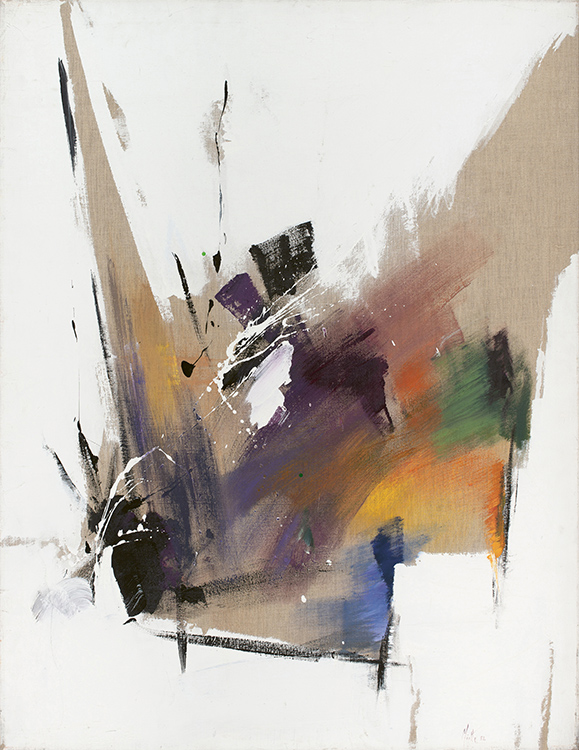
LE BRUIT DE LA VILLE, 1982
Acrylic on canvas
116 x 89 cm / 45.7 x 35 in.
Signed and dated “Miotte 82“ lower right
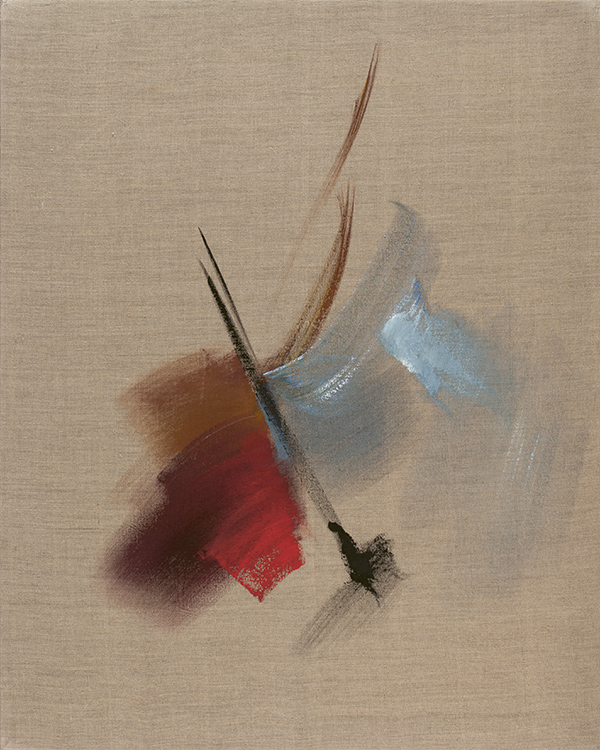
ADAGIO, 1983
Acrylic on canvas
100 x 81 cm / 39.4 x 31.9 in.
Signed and dated “Miotte 83“ on the reverse
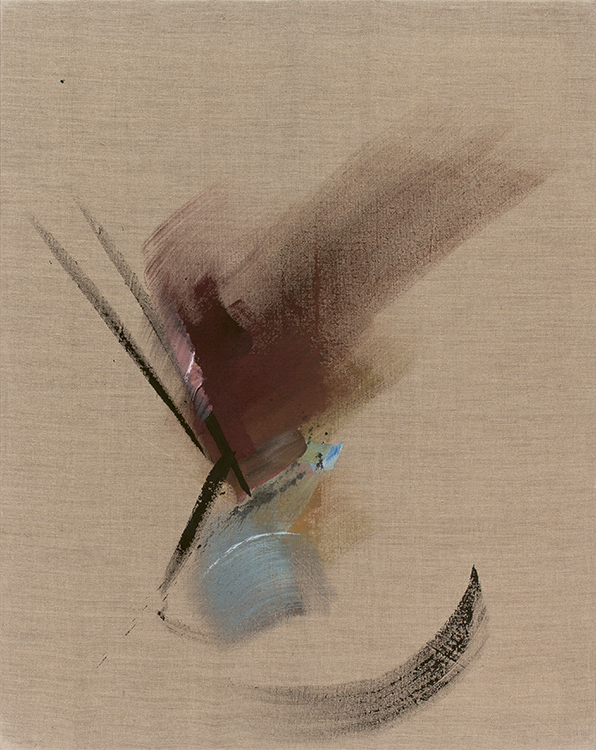
VIVACE, 1983
Acrylic on canvas
100 x 81 cm / 39.4 x 31.9 in.
Signed and dated “Miotte 83“ on the reverse
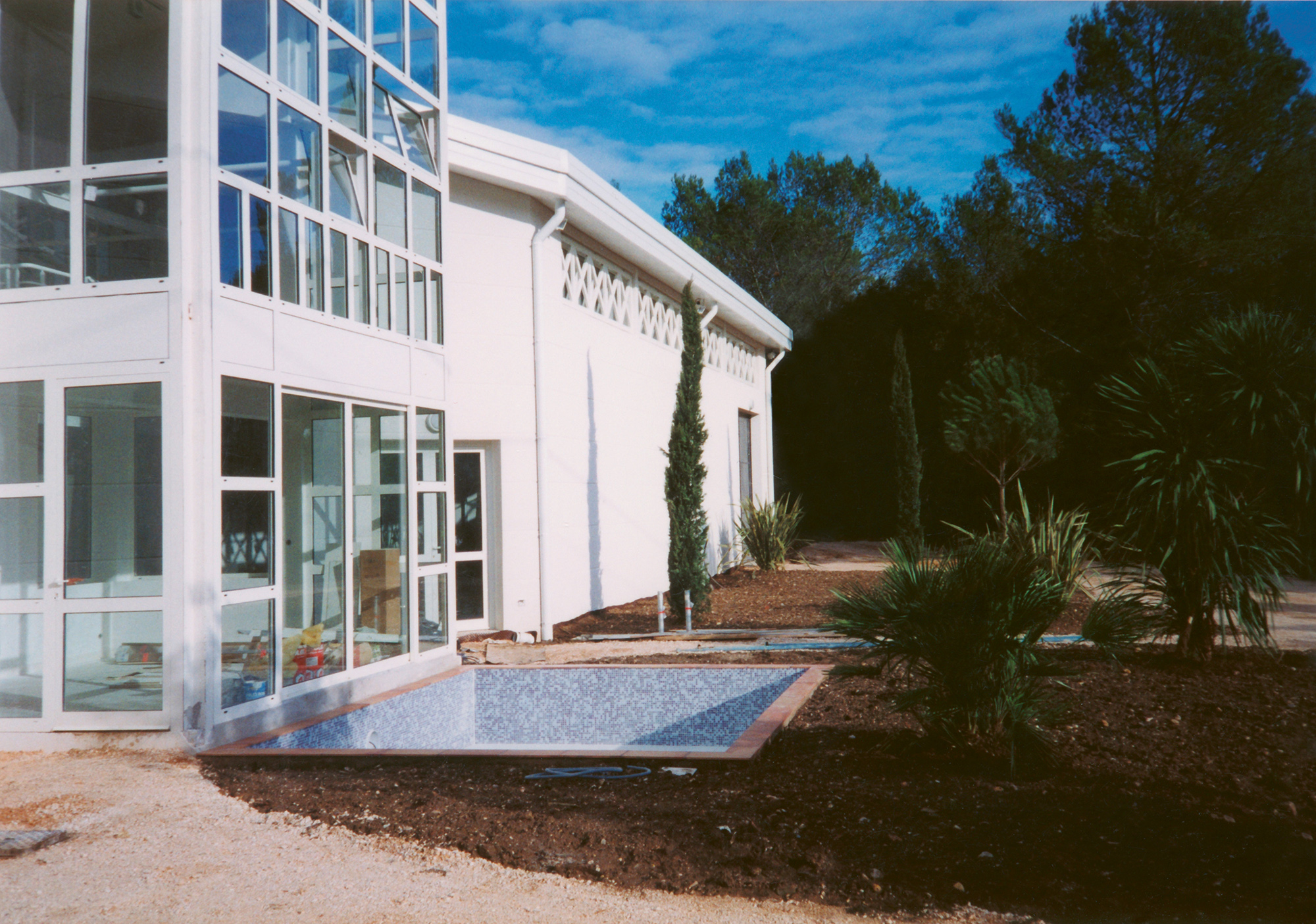
Jean Miotte’s studio at Pignans, France
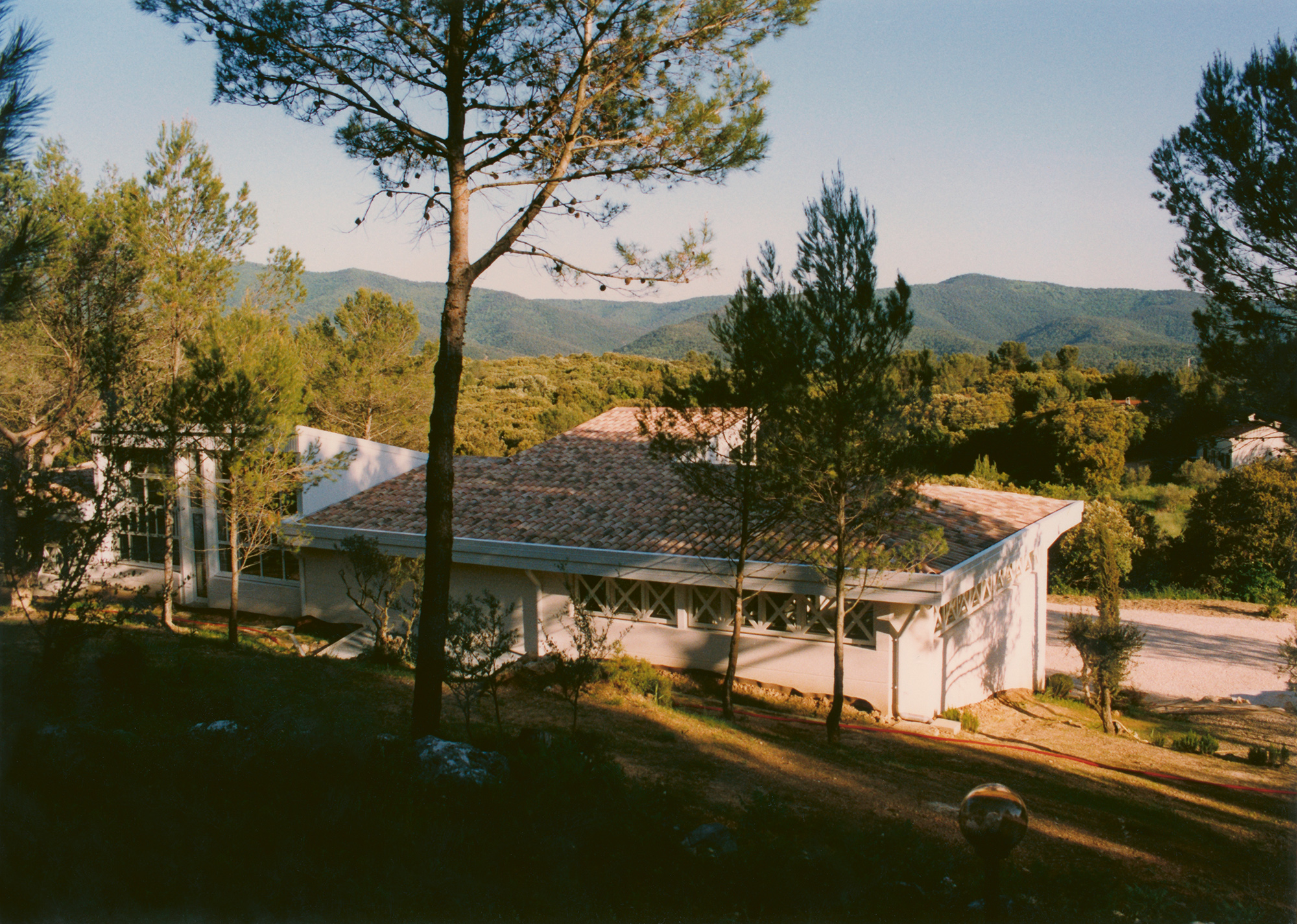
Jean Miotte’s studio at Pignans, France
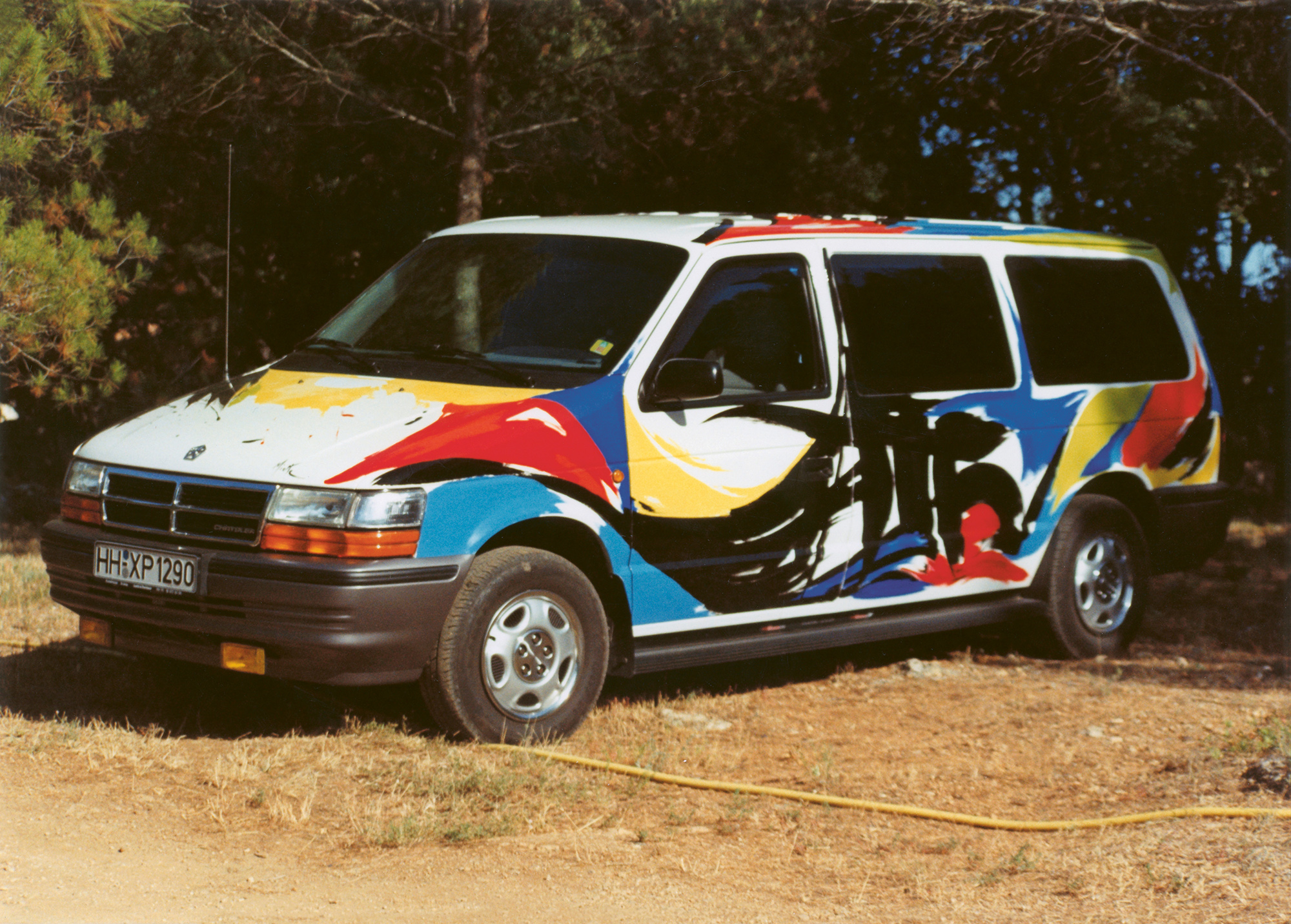
Jean Miotte and the Chrysler dealership for Paris-Dakar, 1993
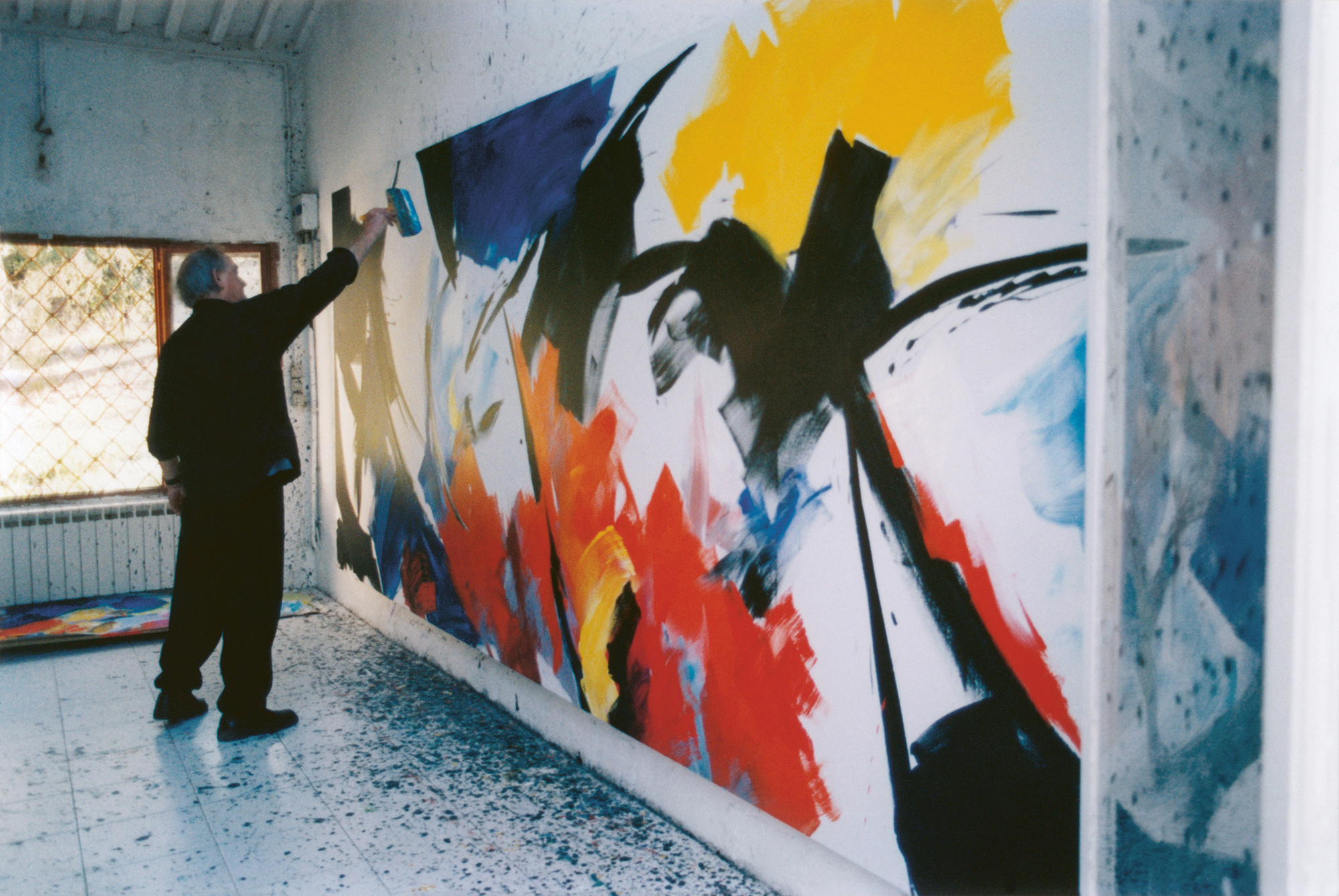
Jean Miotte in his studio, Pignans, France
JEAN MIOTTE
(1926-2016)
THE YEARS OF STUDIES OF THE PAINTER JEAN MIOTTE
Jean Miotte was born in Paris on September 8th, 1926 and spent his youth in Occupied Paris: he was eighteen years old at the end of the war. “It was in this context of upheaval and planetary ideological turmoil that his desire for other values, other spiritual commitments was exacerbated. His hostility towards all forms of regimentation, group effects, dates from this time. At the age of nineteen, he had decided, his path would be solitary” wrote Serge Lenczner.
After studying mathematics, Jean Miotte completed his military service. The artist explained: “I was struck by the ugliness of the facilities and the wall decorations in the surrounding area, and I swore to myself from the moment I saw them that I would transform them.” As such, he began painting the walls in the break rooms – “With Pop Art before its time” noted Miotte, and “Beautiful girls on beaches to entertain the soldiers…” – as well as sets for the barracks theatre.
Stricken with tuberculosis, Miotte’s military service was cut short and he was hospitalised for several months, during which time he practised painting and drawing. Once he had recovered, he continued his artistic endeavours in Paris – which was brimming with activity – and attended a number of free art schools in Montparnasse, such as the Académie de la Grande Chaumière and the studios of Othon Friesz and Ossip Zadkine, among others. At this time, Miotte painted nude models as well as imaginary compositions. He was very interested in Jacques Villon, Georges Rouault and Henri Matisse.
THE IMPORTANCE OF DANCE TO JEAN MIOTTE ’S ART
In 1948, Miotte followed his Russian friends to London where the Ballets Russes de Colonel W. de Basil were performing. It was with great joy that he discovered the world of dance. The artist explained: “I savoured the first wonders and discoveries of the choreographic world, the arabesques, the theatrical organisation of lines, of rhythm…” Miotte became friends with some of the key figures in dance, including the dancers Zizi Jeanmaire, Wladimir Skouratoff and Rosella Hightower, who even asked him to design sets for her choreographic works. Miotte thus became involved with the Grand Ballet du Marquis de Cuevas – whose members included Rosella Hightower and Wladimir Skouratoff – which was based in Monte Carlo. Towards the end of the 1940s, Miotte often depicted dancers in his work. After that, Miotte’s painting became non-figurative, drawing on dramatic play and performance. Movement became fundamental to his work. Jean-Clarence Lambert described his work as a form of “choreographic abstraction”. Miotte wanted to achieve a fusion of the visual and performing arts. “I have a passion for dance and choreography…” he confided, “I dream of a magnificent synthesis of painting, music and choreography.” Throughout his career, Jean Miotte created a number of stage sets and costumes. In 1994, his spectacular five-metre canvas Sud (South) entered the collection of the Opéra Bastille, where it is on display today.
JEAN MIOTTE ’S EARLY SUCCESSES
Jean Miotte travelled to Italy and discovered Quattrocento art. He also met the artists Piero Dorazio, Lorenzo Guerrini and Achille Perilli. On returning to Paris, Jean Miotte was influenced by the paintings of Robert Delaunay and Fernand Léger.
Miotte painted his first abstract painting in 1950. He was living and working in Meudon, where he made friends with the artists Jean Arp and Gino Severini – two key figures, one in the world of abstract art, the other in terms of the importance of movement. Jean Miotte also developed a close relationship with Sam Francis, whom he met in 1952 and visited in his studio in Ville-d’Avray. In 1953, Jean Cassou bought a painting by Jean Miotte for the Musée d’Art Moderne in Paris. In the same year, Miotte had his first exhibition at the Salon des Réalités Nouvelles, an event in which he would participate regularly from then on. The same year, the art critic Michel Seuphor contacted him for his publication Dictionnaire de l’art abstrait which was published in 1957. Miotte’s painting is described in it as: “highly coloured compositions with clearly articulated design that have wall power.” Jean Miotte is a personal work, between Lyrical Abstraction, Informal Art and Tachisme. “The names of the artists who, with their lyricism, are an exception to the general rule of coldness… Jean Miotte, by whom bright and airy painting transmits an undeniable emotion,” wrote the art critic Alain Jouffroy. Jean Miotte’s paintings were created with an immediate gesture, a dazzling energy. “Movement is my life” he recalled. In this, he can be compared to Jackson Pollock.
Jean Miotte never prepared his work with sketches. This differentiated him from Hans Hartung for example. The American art critic Harold Rosenberg appreciated this practice especially: “the most important thing in art is freshness”. This free and instinctive form of painting was also influenced by Surrealism. The spirit was liberated of all constraints of reflection: “it is the intuition that counts above all when a work is born”. Jean Miotte evoked his work as the “result of internal conflicts, my painting is a projection; a succession of acute moments where creation happens in full spiritual tension. Painting is not a speculation of the mind or the intellect, it is a gesture that is carried within.” Jean Miotte met Roberto Matta who told him: “Surrealism is for me a battle. (…) You, too, you’re a fighter, you’re like me, your paintings aren’t abstract.” The influence of Cubism is also present. Just as his predecessors decomposed to recompose, Miotte “unmakes”. According to Karl Ruhrberg, with Jean Miotte, it is “the orchestration of a world that explodes”. He also underlined Jean Miotte’s strong connection to his northern origins, especially Frans Hals, “who, like him allied spontaneous painting and harmony between impulse and balance.”
In 1954, Jean Miotte moved his studio to the townhouse of the sculptor Prince Youriévitch in Boulogne, where the artists Jacques Lanzman and Serge Rezvani were also living. The following year, the painter Henri Goetz brought his pupils to visit this studio. In 1957, Jean Miotte participated in the exhibition 50 Ans d’Art Abstrait at the Galerie Creuse in Paris. A solo exhibition of his work was held at the Galerie Lucien Durand in the same city. From 1958, Jean Miotte was represented in Europe by the dealer Jacques Dubourg. That year, Jean Miotte met the painters André Lanskoy, Serge Poliakoff and Pierre Dmitrienko.
Jean Miotte became successful in Germany where ten exhibitions were devoted to his work during the 1950s, for example at the Kunsthalle of Recklinghausen in 1958. He was also included in a group exhibition of fifteen painters at the Cologne Kunstverein. In 1960, the Ludwig Museum of Cologne acquired a work by Jean Miotte.
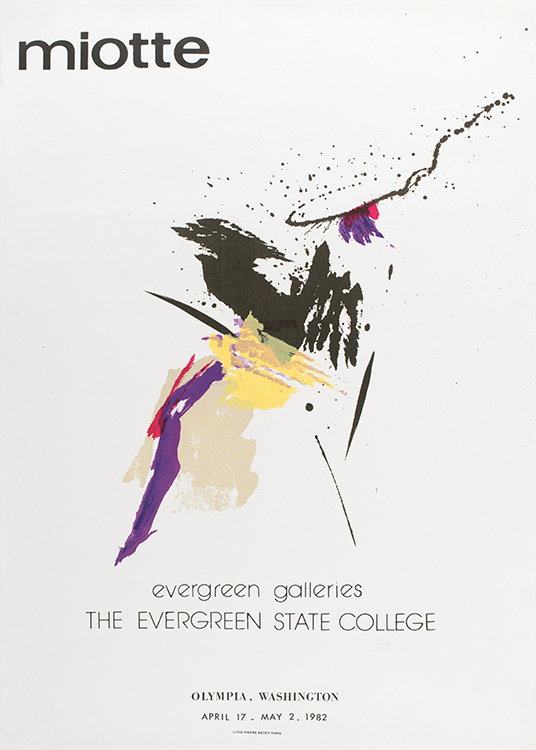
Poster for the Miotte exhibition,
Evergreen galleries, Olympia
Washington DC, USA, 1982
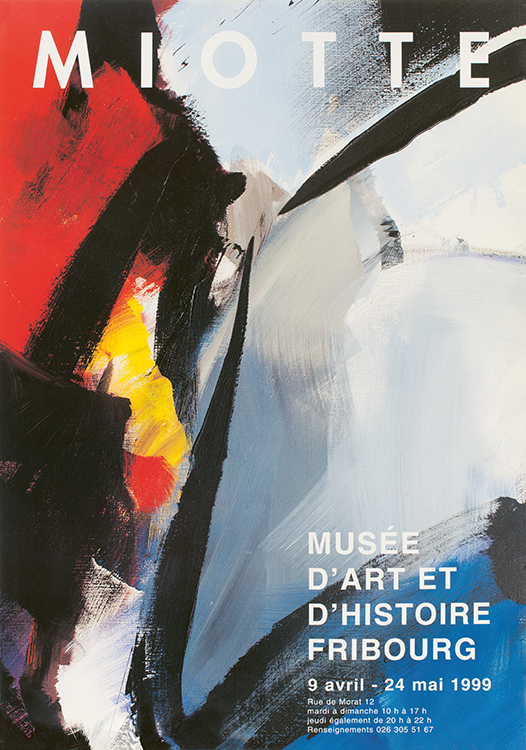
Poster for the Miotte exhibition,
Museum of Art and History, Friborg
Switzerland, 1999
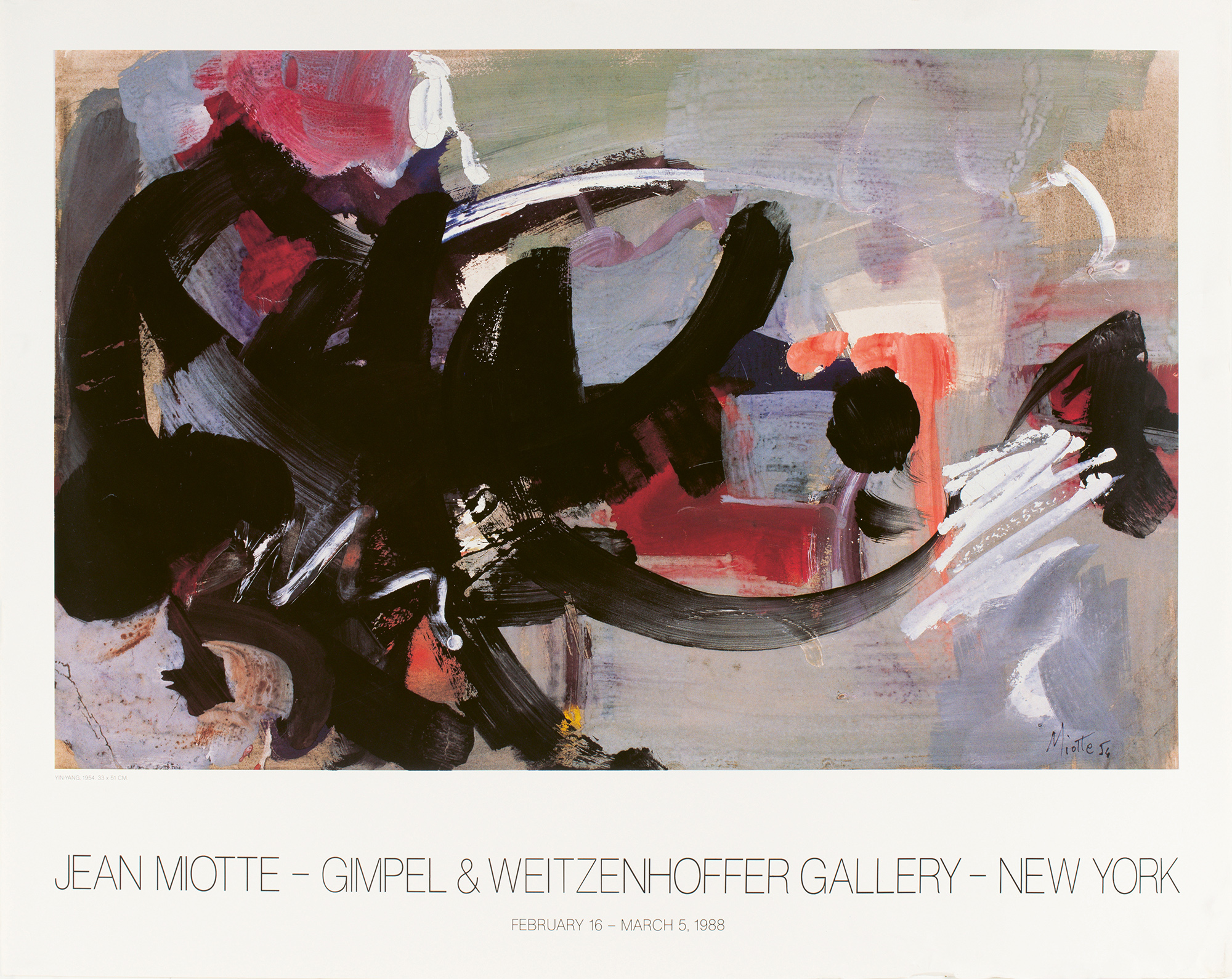
Poster for the Jean Miotte, Gimpel & exhibition
Weitzenhoffer Gallery, New York, NY, USA, 1988
THE PAINTER JEAN MIOTTE ’S FIRST TRIP TO THE USA
Jean Miotte exhibited at the first Paris Biennale in 1959 in the “Section Informels” with Raymond Hains, LeRoy Neiman, Peter Foldes and André Favory. The following year, two paintings by Jean Miotte were included in the inaugural exhibition of the Galerie Karl Flinker in Paris. Paintings by him were also included in the inaugural exhibition of the Galerie Iris Clert. In 1961, Jean Miotte participated with Sam Francis, Georges Mathieu and Jean-Paul Riopelle in the group exhibitions of the Swenska-Franska Gallery in Stockholm and the Galerie Bonnier in Lausanne. That year, he was awarded the Ford Foundation Prize and was invited to spend six months in the USA. The following year, a solo show of his work was organized by the Iolas Gallery in New York. Jean Miotte met the American artists Robert Motherwell, Mark Rothko, Chaïm Jacob Lipchitz and Alexander Calder. He travelled around the USA and gave a lecture at Colorado Spring University.
INTERNATIONAL RECOGNITION FOR THE PAINTER JEAN MIOTTE
In 1963, a Jean Miotte retrospective was organized by the Stedelijk Museum of Schiedam and it then transferred to the Groningen Museum in the Netherlands. Jean Miotte participated the same year in the group exhibition Art Contemporain at the Grand Palais in Paris. In February 1964, the Portuguese art historian José-Augusto França wrote about Jean Miotte’s painting in the magazine Costruire: “A gestural painter in the French spirit, Miotte expresses himself in the constructive despite the impression of immediate vehemence that emanates from his paintings his art goes beyond the post-war aesthetic, standing out in a more modern way by a conscience of the independence of the idea of creating.” During the 1960s, many exhibitions of Jean Miotte’s work were organized in Germany, the Netherlands, Denmark and in Belgium. At that time, he worked in the south of France, at Pignans. In 1967, he was again included in an exhibition at the Schiedam Stedelijk Museum, the group show Huit peintres de Paris, along with Chafik Abboud, Olivier Debré, Karskaya, Jean Messagier, Carl Moser, Louis Nalard and Paul Rebeyrolle.
In 1970, Jean Miotte became a member of the Comité des Réalités Nouvelles. He exhibited forty paintings at the Fondation Prouvost at Marcq-en-Baroeul. In 1971, Jean Miotte started using hessian bare canvas as an element in his compositions. The following year, he again spent time in the USA, this time in New York and Washington. Forty-six of his canvases were exhibited at the International Monetary Fund in Washington. Jean Miotte moved his studio to Hamburg in Germany. In 1975, a monograph on Jean Miotte was published, containing a text by the dealer Castor Seibel: “no imitation, no reproduction, but the internal event finds its expression in the colours and a gestural dynamic… Miotte’s painting is a place where the contradictions of our age are no longer expressed in a dualist way… In this sense, J.M. is an important creator of new forms.” The following year, Jean Miotte experimented with paper as a support and made eighty gouaches as well as collages of brown paper and newspaper. One of his works was acquired by the Museum of Maassluis in the Netherlands. He exhibited in Padua alongside Enrico Baj, Alexander Calder and Karel Appel. Jean Miotte moved his studio to Vitry-sur-Seine. He exhibited at the Malines cultural centre in Belgium at the group show Kunst in Europa 1920- 1960 which brought together the big names in contemporary art of the time.
In 1978, Jean Miotte was invited to speak in the context of exhibitions of his work at the French cultural centre in Damascus and then at the museum of Alep in Syria and finally in Amman in Jordan. The same year, he moved his studio to New York where he was represented by the Martha Jackson Gallery. His work was shown at exhibitions about French painting from the 1950s at the Maison de la culture de Grenoble, at the Musée de Dunkerque and at the Musée de Saint-Omer in France.
JEAN MIOTTE ’S TRAVELS IN ASIA
In May 1980, Jean Miotte exhibited fifty works in Beijing at the French cultural centre. He was the first western painter to be invited to exhibit his work in Beijing after Mao’s death. Jean Miotte took this opportunity to travel around China. In 1982, he exhibited sixty paintings at the Hong Kong Art Center and then at the French-Japanese Institute of Tokyo. The following year, Jean Miotte exhibited at the Singapore National Museum and at the National Museum of History of Taipei. In 1984, he was exhibited at the Striped House Museum of Tokyo.
The Guggenheim Museum acquired two works on paper by Jean Miotte in 1987. In 1991, the Centre Georges Pompidou in Paris exhibited the prints commissioned by Danielle Mitterrand for her album Mémoire de la liberté. Fifty-five artists were involved in this project including Jean Miotte, Roy Lichtenstein, Antoni Tapies, Sam Francis and Robert Rauschenberg. The following year, a Jean Miotte retrospective was organized at the Palais des Arts de Toulouse.
The Jean Miotte Foundation was opened in New York in 2002 with a permanent collection of his works. It is nowadays based in Fribourg (Switzerland). Jean Miotte died on March 1st, 2016 at the age of 89.

Jean Miotte, New York, NY, États-Unis, 1990
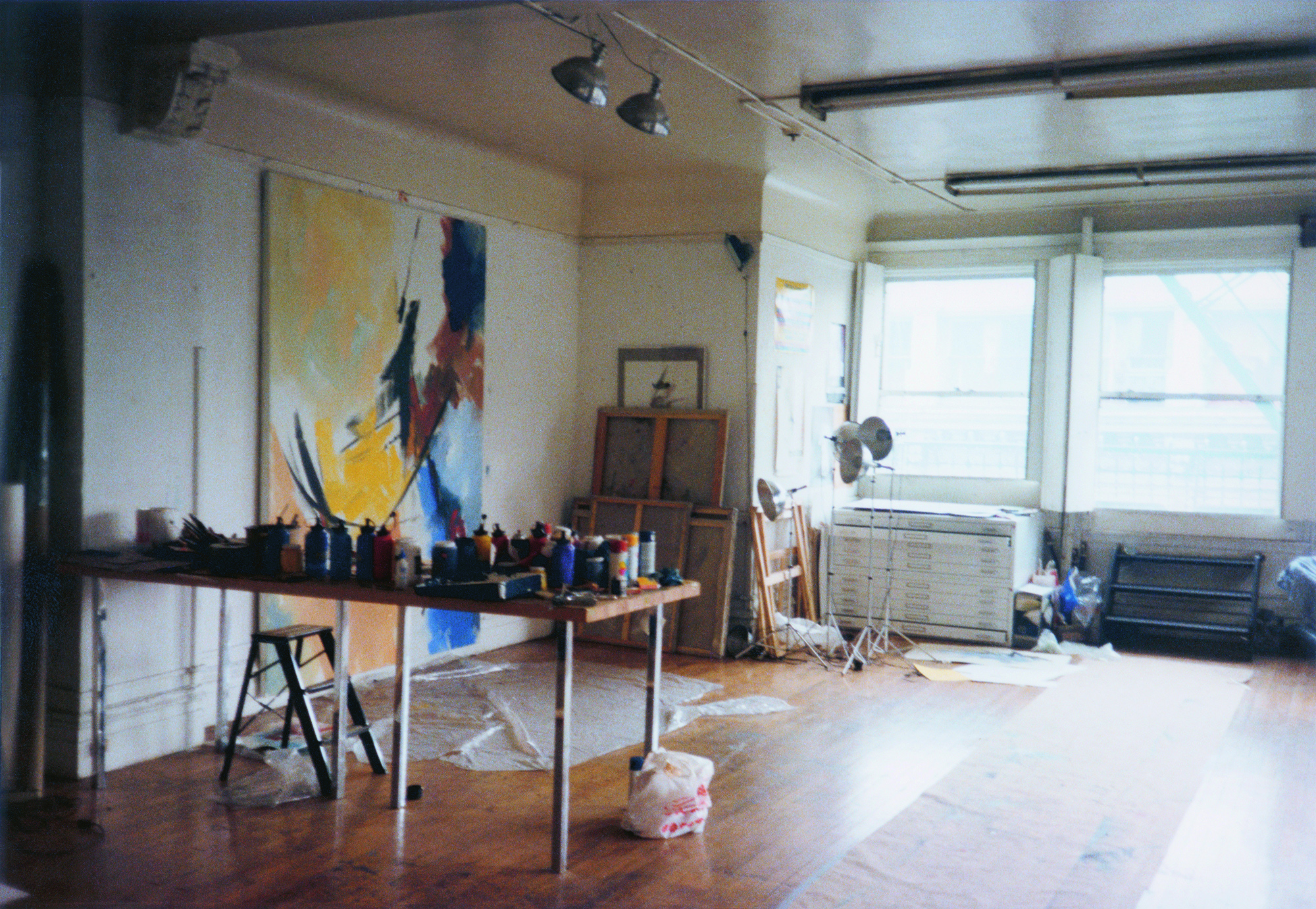
Jean Miotte’s studio, New York, NY, United States, 1989
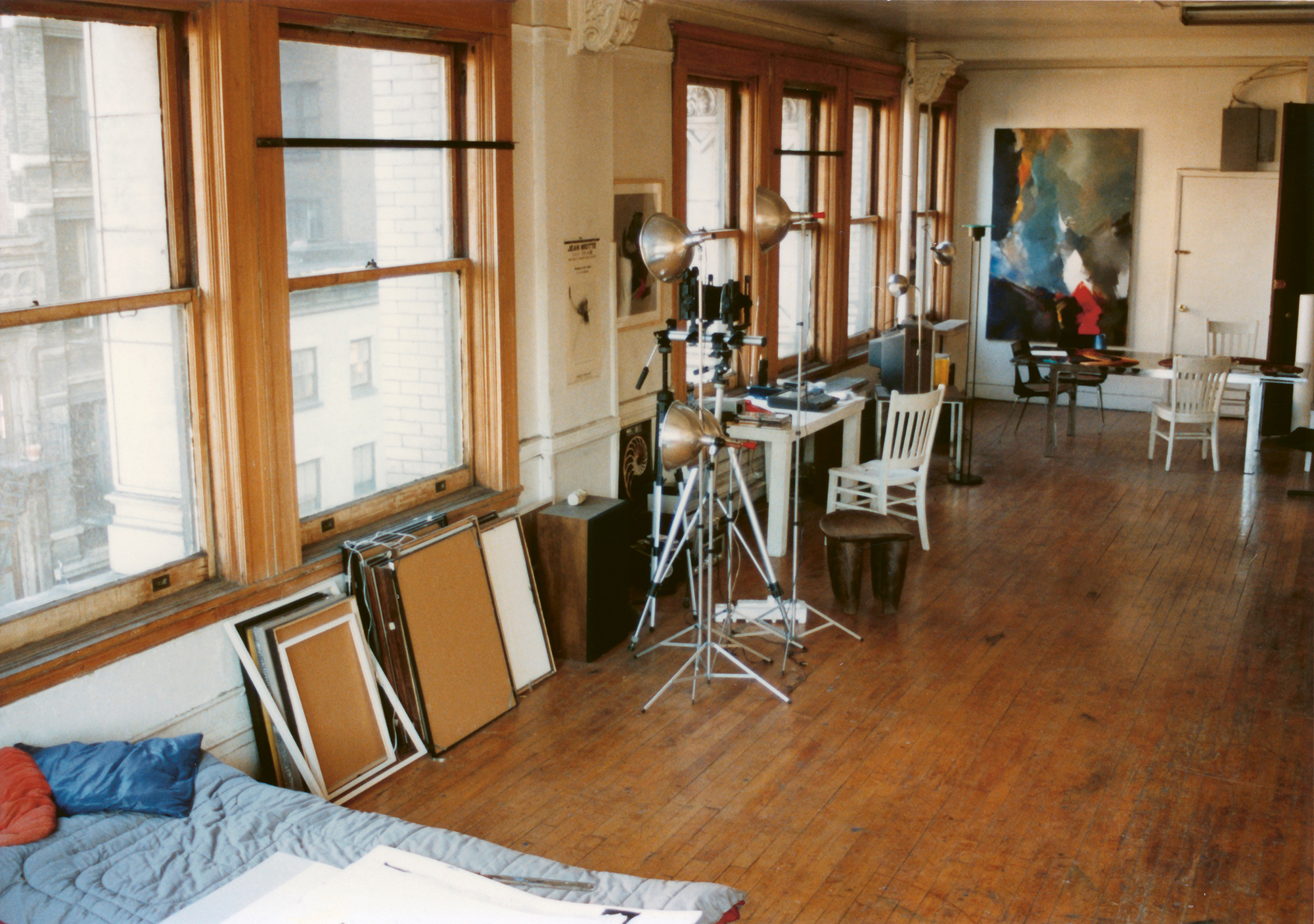
Jean Miotte’s studio, New York, NY, United States
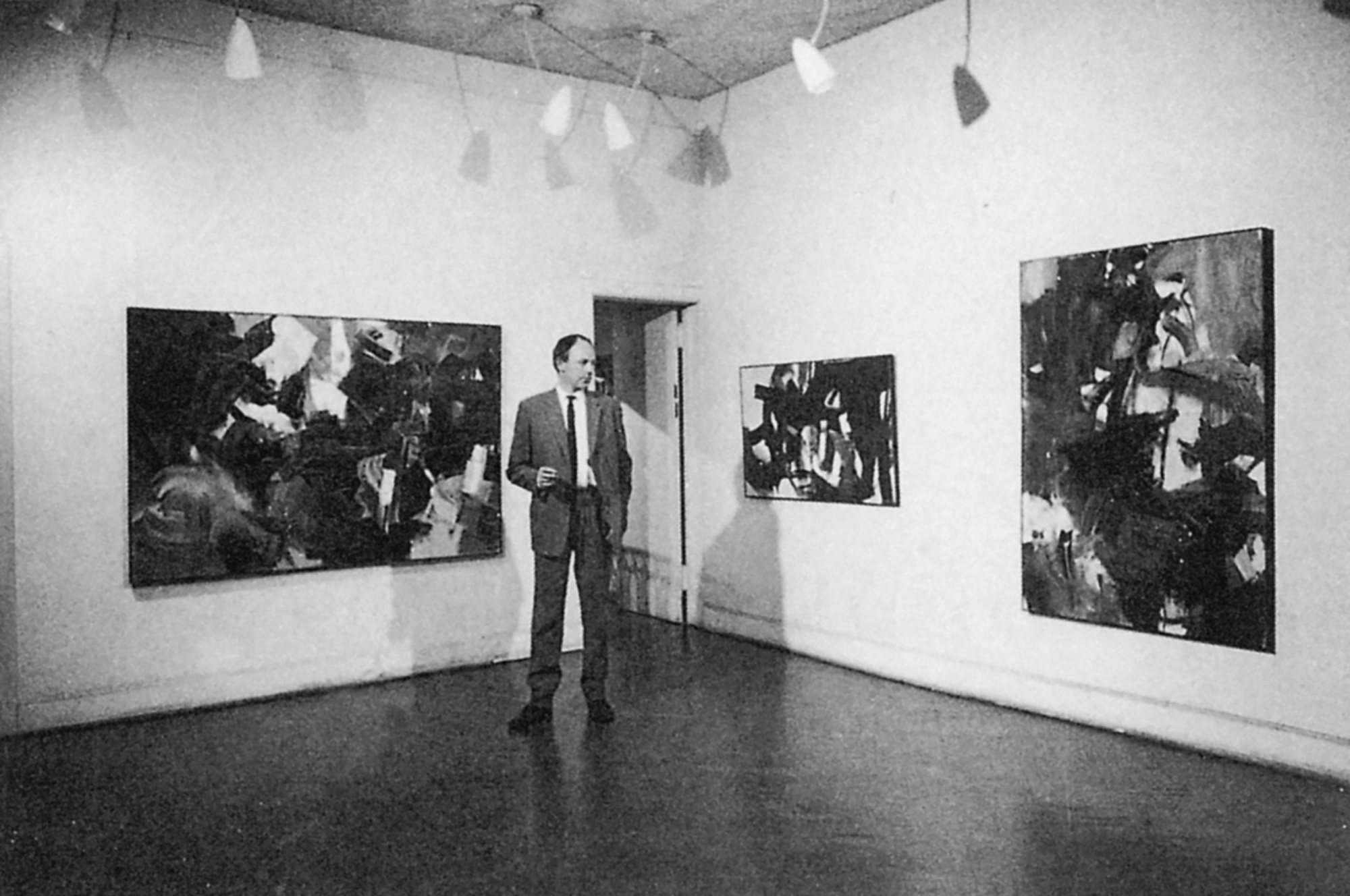
Galerie Iolas, New York, NY, États-Unis, 1962
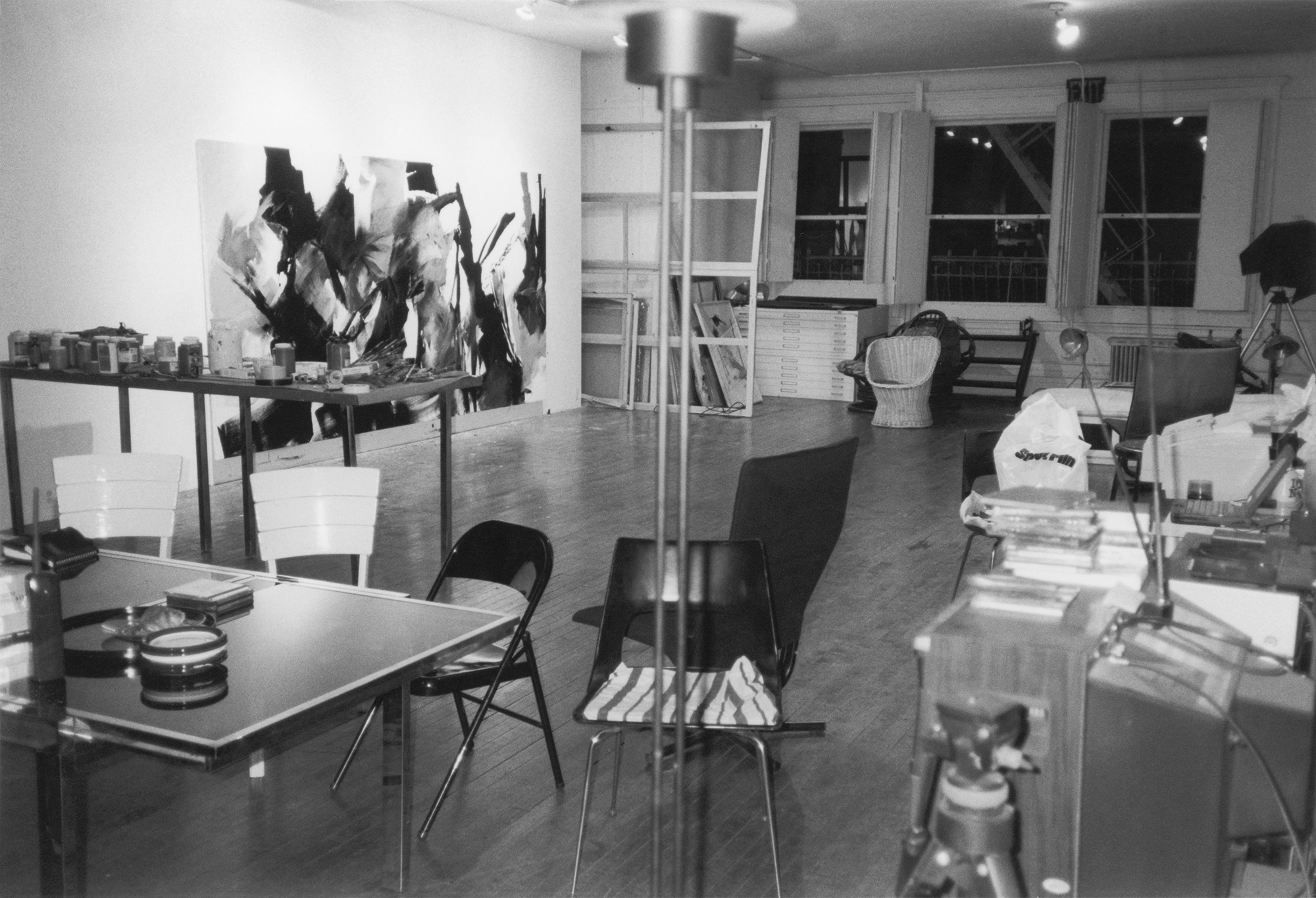
Jean Miotte’s studio, New York, NY, États-Unis, 1989
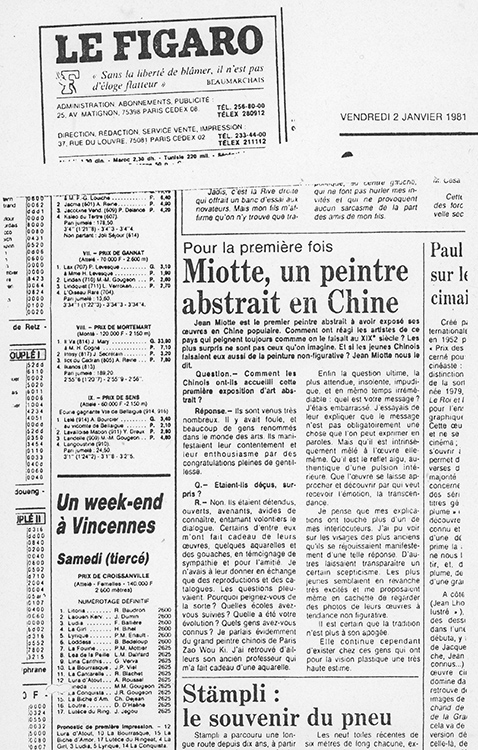
Pour la première fois Miotte, un peintre abstrait en Chine, Le Figaro, January 2, 1981
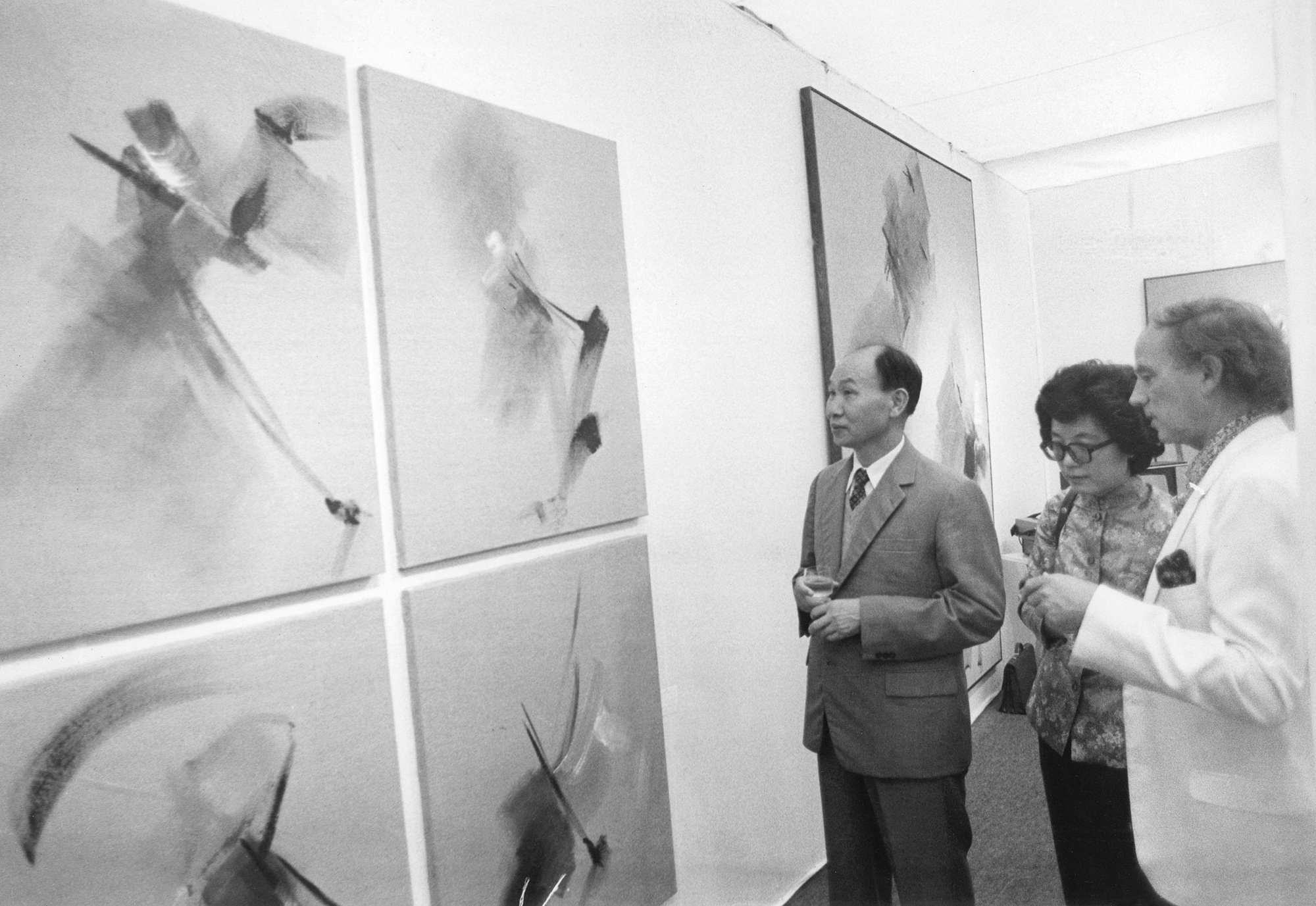
Jean Miotte with cultural advisors from the People’s Republic of China, FIAC,
Grand Palais, Paris, September 23, 1983 – Photo: France-Soir, Serge Lansac
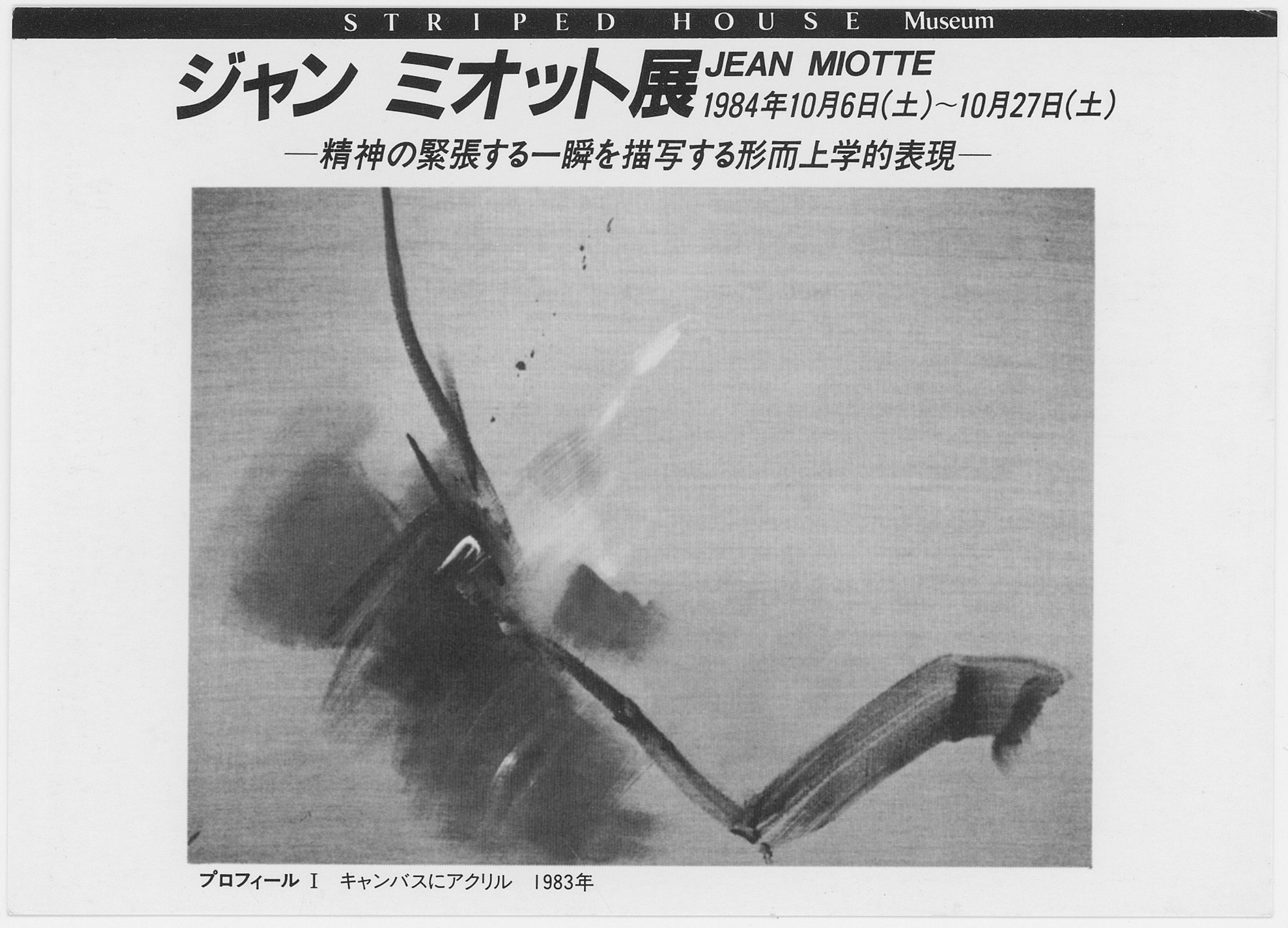
Invitation card to the Jean Miotte exhibition, Striped House Museum, Tokyo, 1984
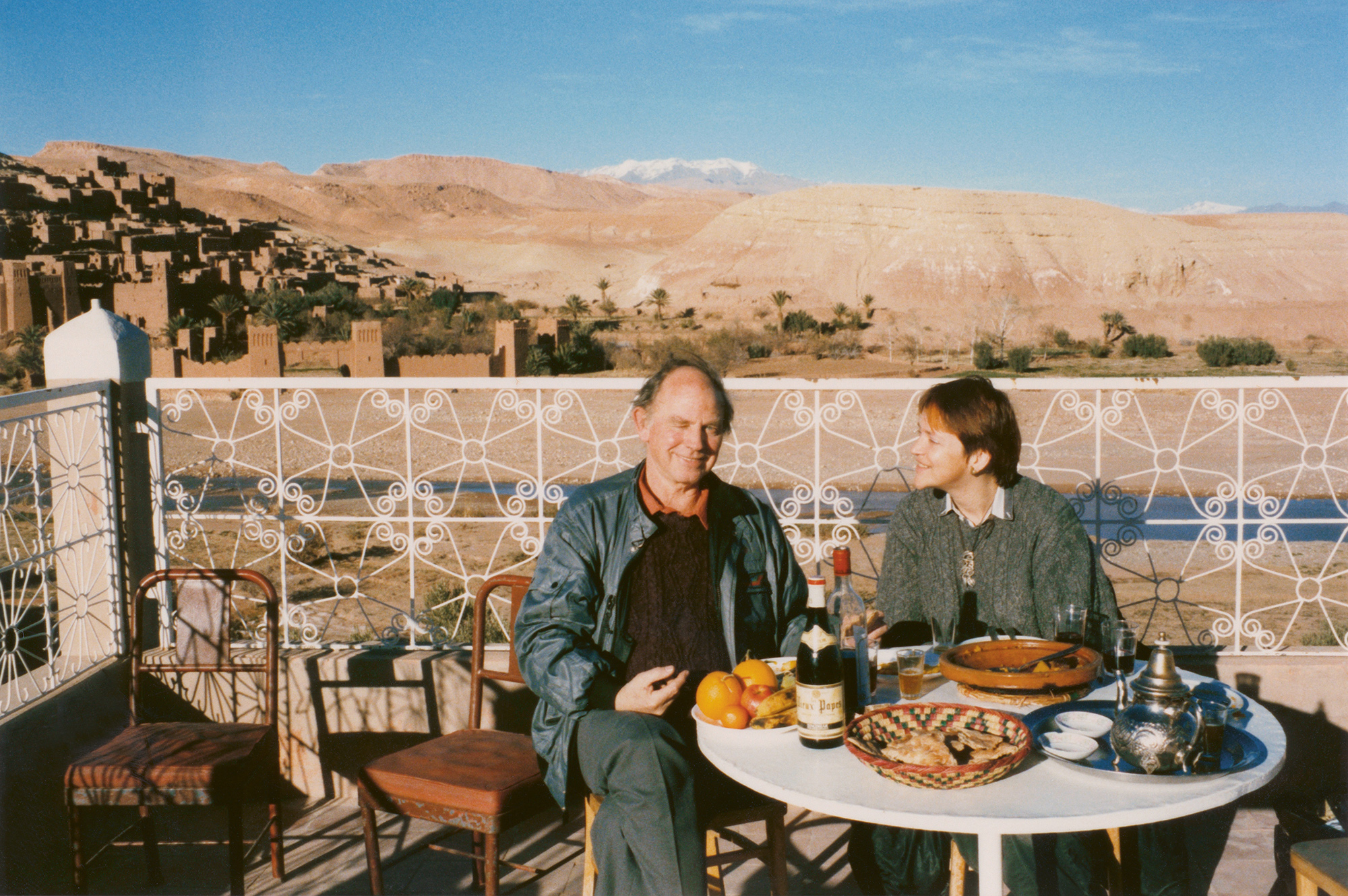
Jean Miotte and his wife Dorothée Keeser, Morocco
SELECTED COLLECTIONS
Berlin, Allemagne, Graphotek
Castellon, Espagne, Museo de Arte
Contemporáneo de Villafamés
Cologne, Allemagne, Museum Ludwig
Dortmund, Allemagne, Museum am Ostwall
Dhaka, Bangladesh, Musée National du Bangladesh
Dunkerque, France, Musée d’Art contemporain
Hambourg, Allemagne, Staats-und
Universitätsbibliothek Hamburg Carl von Ossietzky
Maassluis, Pays-Bas, Gemeentemuseum
Munich, Allemagne, Staatsgalerie Moderner Kunst
New York, NY, États-Unis, The Solomon R.
Guggenheim Museum
New York, NY, États-Unis, The Museum of Modern Art
New York, NY, États-Unis, The Chelsea Art Museum
Paris, France, Musée d’Art moderne de Paris
Paris, France, Bibliothèque Nationale
Paris, France, Ministère des Affaires culturelles
Paris, France, Opéra national Bastille
Paris – La Défense, France, Fonds national d’art contemporain (FNAC)
Paris – La Défense, France, Fondation d’Art contemporain CNIT
Rio de Janeiro, Brésil, Museo de Arte moderna
Saarbrucken, Allemagne, Saarlandmuseum, Moderne Galerie
Singapour, Musée National de Singapour
Taichung, Taïwan, Musée des Arts de Taïwan
SELECTED EXHIBITIONS
Salon des Réalités Nouvelles, Paris, France, 1953. Régulières participations par la suite
Exposition d’ouverture, Galerie du Haut du Pavé, Paris, France, 1954
50 ans d’art abstrait, à l’occasion de la parution du Dictionnaire de la Peinture abstraite de Michel Seuphor, Galerie Creuse, Paris, France, 1957
Galerie Lucien Durand, Paris, France, 1957
Réalités nouvelles, nouvelles réalités, 13e salon des Réalités Nouvelles, Kunsthalle de Recklinghausen, Recklinghausen, Allemagne, 1958
Cinq peintres de Paris : Bogart, Bysantios, Jousselin, Miotte, Mihailovitch, Galerie Attico, Rome, Italie, 1958
Section Informel : Hains, Miotte, Neiman, Foldes, Favory…, première Biennale de Paris, Paris, France, 1959
15 peintres de Paris, Kolnischer Kunstverein, Cologne, Allemagne, 1959, 1962
Ouverture, Galerie Flinker, Paris, France, 1960
Ouverture, Galerie Iris Clert, Paris, France, 1960
Galerie Am Dom, Francfort, Allemagne, 1960
Galerie Gunar, Düsseldorf, Allemagne, 1960
Exposition Internationale, Museum Wolfram Von Eschenbach, Wolframs-Eschenbach, Allemagne, 1961
Sam Francis, Mathieu, Miotte, Riopelle, Galerie Swenska Franska, Stockholm, Suède, 1961
Galerie Bonnier, Lausanne, Suisse, 1961
Drian Gallery, Londres, Angleterre, 1961
Centre Culturel de Mechelen, Malines, Belgique, 1961, 1976
Galerie Iolas, New York, NY, États-Unis, 1962
Galerie Jacques Dubourg, Paris, France, 1963
Stedelijk Museum, Schiedam, Pays-Bas, 1963, 1967
Musée de Groningen, Groningen, Pays-Bas, 1963
Galerie Zodiaque, Bruxelles, Belgique, 1963
Grand Palais, Paris, France, 1963, 1988
Cobra et l’Informel : Appel, Constant, Corneille, Miotte, Riopelle, Tal Coat, Galerie Krikhaar, Amsterdam, Pays-Bas, 1965
Galerie Dierks, Aarhus, Danemark, 1966, 1968, 1971
Court Gallery, Copenhague, Danemark, 1966
Galerie Bio, Aalborg, Danemark, 1967
International graphies, The Corcoran Gallery of Art, Washington, DC, États-Unis, 1970
Galerie Wünsche, Bonn, Allemagne, 1970, 1974, 1976
Septentrion, Centre artistique de la Fondation A. Prouvost, Marcq-en-Baroeul, France, 1970
Huit Peintres de Paris : Abboud, Debré, Karskaya, Messagier, Moser, Miotte, Nalard, Rebeyrolle, Maison de la Culture, Bourges, France, 1971
International Monetary Fund, Washington DC, États-Unis, 1972
Galerie Dinastia, Lisbonne, Portugal, 1972
Prudhoe Gallery, Londres, Angleterre, 1973, 1974
Galerie Winter, Braunschweig, Allemagne, 1975, 1978
Galerie Nieuwe Weg, Doorn, Pays-Bas, 1976, 1979, 1984, 1991
Cinq artistes : Appel, Baj, Calder, Miotte, Scordia, Galerie Alfiere, Padoue, Italie, 1976
Bishops Gallery, Melbourne, Australie, 1977
Damascus Cultural Center, Damas, Syrie, 1978
National Museum, Alep, Syrie, 1978
Amman Cultural Center, Amman, Jordanie, 1978
Musée de Dunkerque, Dunkerque, France, 1978, 1993
L’Abstraction des Années 50 en France, Maison de la Culture, Grenoble, France, 1978
L’Abstraction des années 50 en France, Musée de Saint-Omer, France, 1978
Exposition rétrospective itinérante dans des centres culturels français, 1979
Centre Culturel de Pékin, Pékin, Chine : Première exposition d’un artiste occidental en Chine Populaire, 1980
Galería Lucas, Gandie, Espagne, 1980, 1981
Galerie Koppelmann, Leverkusen, Allemagne, 1980, 1983
Centre Culturel, Montpellier, France, 1980
Ayala Museum, Manille, Philippines, 1981
Musée de la Poste, Hambourg, Allemagne, 1981
Evergreen Galleries, The Evergreen State College,
Olympia, Washington DC, États-Unis, 1982
Hong-Kong Arts Center, Hong-Kong, 1982
Institut Franco-Japonais de Tokyo, Tokyo, Japon, 1982
Trevisan Galleries, Edmonton, Canada, 1982
Paris 59 : Fautrier, Feraud, Hartung, Lanskoy, Lipsi, Miotte, Schneider, Sonderborg, Soulages, TaI Coat, Tapies, Galerie Koppelmann, Cologne, Allemagne, 1982
National Museum de Singapour, Singapour, 1983
National Museum of History, Taipei, Taïwan, 1983
Bitran, Chu teh-Chun, Hartung, Miotte, Soulages, Chapelle des Franciscains, Saint-Nazaire, France, 1983
Galerie La Cité, Luxembourg, 1983, 1987
Striped House Museum, Tokyo, Japon, 1984
Vik Gallery, Edmonton, Canada, 1984
Institut Français d’Athènes, Athènes, Grèce, 1984
Deux peintres, deux sculpteurs, Orangerie de Bagatelle, Paris, France, 1984
Opus Gallery, Miami, FL, États-Unis, 1985
Konstmassan, Stockholm, Suède, 1985, 1989
Art Atrium, Stockholm, Suède, 985
Columbia University, New York, NY, États-Unis, 1986
Galerie Keeser, Hambourg, Allemagne, 1987, 1989, 1991
Les Peintres autour d’Arrabal, Musée d’Histoire, Eschsur-Alzette, Luxembourg, 1987
Ciae, Chicago International Art Exhibition, Chicago, IL, États-Unis, 1987
Colloque Euro-Arabe, Musée de Malte, Île de Malte, 1987
Art in Paris, Pavillon Inter-Continental, Singapour, 1987
Galerie Gimpel & Weitzenhoffer, New York, NY, États-Unis, 1988
Galerie Egelund, Copenhague-Holte, Danemark, 1988, 1990
Espace d’Art Contemporain E. Ungaro, La Rochelle, France, 1988
Rencontres écrites, Institut du Monde Arabe, Paris, France, 1988
Les années 50: Benrath, Chu teh-Chun, Debré, Dietrich Mohr, Féraud, Hartung, Lanskoy, Miotte, Music, Père, Pichette, de Staël, Subira Puig, Casino de Hyères, Hyères, France, 1988
Les années 50, Mécénat Pernod, Paris-Créteil, France, Première étape d’une exposition itinérante, 1988
Galerie N’namdi, Detroit, MI, États-Unis, 1989
Miotte/Arrabal, Maler und Dichter, Institut Français de Hambourg, Hambourg, Allemagne, 1989
Galerie von Braunbehrens, Munich, Allemagne, 1990, 1992, 1996
Galerie Wild, Francfort, Allemagne, 1990, 1992, 1994, 1997
Abstrakte Malerei nach 1945 : Miotte, Noël, Schumacher, Sonderborg, Thieler, Haus Sandreuther, Riehen-Bâle, Suisse, 1990
Art et Partage, Musée des Beaux-Arts, Nice, France, 1990
Musée Seibu, Tokyo, Japon, 1991
Galerie Jade, Colmar, France, 1991, 1992
Galerie Michael Schultz, Berlin, Allemagne, 1991, 1993, 1997
Mémoire de la Liberté : 55 artistes de 23 pays, César, Sam Francis, Miotte, Rauschenberg, Motherwell, Lichtenstein, Tinguely, Tapies, etc., illustrent chaque article de la Déclaration universelle des Droits de l’Homme, organisée par l’Association France Liberté, Centre Pompidou, Paris, France, 1991
Collections des collections ; de Paul Klee à nos jours, CNIT, Fondation d’Art Contemporain, Paris-La Défense, France, 1991
Couleurs de la vie, exposition itinérante internationale d’art contemporain sous le patronage de Mme Danielle Mitterand, Bibliothèque Nationale, Paris, France, 1991
Forms of Abstraction, N’namdi Gallery, Birmingham, MI, États-Unis, 1991
Palais des Arts, Toulouse, France, 1992
Galerie Shuyu, Tokyo, Japon, 1992
Galerie Saint-Polly, Gunrua, Japon, 1992
Art and Art, Nicaf 92, Yokohama, Japon, 1992
Grands formats, Miami Art Fair, Miami, FL, États-Unis, 1992
Art Multiple, Düsseldorf, Allemagne, 1992, 1994
5 artistes des années 50 : Christophorou, Debré, Miotte, Féraud, Koch, Centre Culturel Jean Despas, Saint-Tropez, France, 1993
Hartung et Miotte, Ishi Gallery, Osaka, Japon, 1993
Musée des Cordeliers, Châteauroux, France, 1994
Œuvres graphiques, Musée Bertrand, Châteauroux, France, 1994
30 ans après : Sam Francis, Jean Miotte, Joan Mitchell, Jean-Paul Riopelle, organisée par Chapel Art Center, Hambourg et Cologne, Allemagne, 1994, 1995, 1997
Pour la paix et la reconstruction au Liban – 33 peintres, Musée Sursock, Beyrouth, Liban, 1994
Chinesische Kunst nach 1945 in Europa – Eine Gegenüberstellung: Li Di, Chu teh-Chun, Zao, Rétrospective 1956-1996, Musée Mücsarnok, Budapest, Hongrie, 1996
Les années 1945-1975, Maison de l’Unesco, Paris, France, 1996
Arrabal, der Lyriker und die Künstler, Dali, Dorny, Miotte, Saura, Gutenberg Museum, Mayence, Allemagne, 1996
The Garner Tullis Donation, The Ackland Art Museum, Chapel Hill, CN, États-Unis, 1996
Museum Am Ostwall, Dortmund, Allemagne, 1997, 1999, 2000
Ont-ils du métier ? Propositions pour l’art vivant – Agam, Boltansky, César, Claisse, Cruz. Diez, Hains, Honegger, Messager, Miotte, Morellet, Nemours, Soto, Tinguely, Vasarely, Venet…, Galerie Denise René, Paris, France, 1997
Grenzganger (qui traversent la frontière) : Sandro Chia, lan Hamilton Finlay, Markus Lüppertz, Jean Miotte, A.R. Penck, Bernd Zimmer, pour le 200e anniversaire de Heinrich Heine, Kunsthalle Düsseldorf, Staatsgalerie Stuttgart, Allemagne, Goethe institut Paris et Marseille, France, Villa Romana, Florence, Italie, 1997
20 ans d’exposition, Museum Haus Ludwig für Kunstausstellungen, Saarlouis, Allemagne, 1997
Arbeiten auf Papier (œuvres sur papier), Kunstmarkt Dresde, Dresde, Allemagne, 1997
The National Arts Club, New York, NY, États-Unis, 1998
Van Der Togt Museum, Amsterdam-Amstelveen, Pays-Bas, 1998
Villa Haiss, Musée d’Art Contemporain, Zell A.H., Allemagne, 1998, 2000
Musée d’Art et d’Histoire, Fribourg, Suisse, 1999
Museum Ludwig, Coblence, Allemagne, 2000
Aboa Vetus Ars Nova Museum, Turku, Finlande, 2000
Musée de la ville de Brno, République Tchèque, 2002
Chelsea Art Museum, New York, NY, États-Unis, 2003, 2005
Museo Fundacion Cristóbal Gabarrón, Valladolid, Espagne, 2005
Artrium, Genève, Suisse, 2005
Bibliothèque nationale de Nice, Nice, France, 2005
Jean Miotte, Galerie Diane de Polignac, Paris, France, 2019
Jean Miotte, un geste qu’on porte en soi, Galerie Diane de Polignac, Paris, France, 2021
Jean Miotte & la danse, une abstraction chorégraphique, Galerie Diane de Polignac, Paris, France, 2023
Jean Miotte, Return to China, Galerie Almine Rech, Shanghai, 2025
SELECTED BIBLIOGRAPHY
Michel Seuphor, Dictionnaire de la peinture abstraite, Paris, Fernand Hazan, 1957
Sam Francis, Georges Mathieu, Jean Miotte, Charles Maussion, Jean-Paul Riopelle, cat. expo., Cologne, Kunstverein, 1962
Karskaya, Debré, Abboud et autres, cat. expo., Bourges, Maison de la Culture de Bourges, 1972
Michel Ragon, Histoire de l’art abstrait, vol. IV, Paris, Maeght, 1975
José-Augusto França, Castor Seibel, Miotte, Paris, La Porte Verte, 1975
Chester Himes, Miotte, Palaiseau, SMI (L’art se raconte), 1977
Jean Miotte (texte), Écriture et signes, cat. expo., Athènes, Institut français d’Athènes, 1984
Gérard Xuriguera, Les années 50, Paris, Arted, 1985
Fernando Arrabal, Jean Miotte, Devoirs de vacances, été 85, Paris, Galilée, 1986
Marcelin Pleynet, Miotte, Œuvres sur papier 1950-1965, Paris, Galilée, 1987
Marcelin Pleynet, Miotte, Paris, La Différence, 1987
Collectif, Miotte, Paris, La Différence, 1988
Claude Michel Cluny, Miotte, Peintures et Gouaches, Paris, La Différence (L’Autre Musée), 1989
Mustapha Chelbi, L’affiche d’art en Europe, Paris, Van Wilder, 1989
Jean-Luc Chalumeau, Miotte, Paris, Fragment (Passeport), 1990
Michel Bohbot, Miotte, Le Geste majeur, Paris, Navarra, 1991
Mémoire de la liberté, cat. expo., Paris, Centre Georges Pompidou, 1991
Jean-Clarence Lambert, Le règne imaginal, Paris, Cercle d’Art (Diagonales), 1992
Lydia Harambourg, L’École De Paris, 1945-1965: Dictionnaire des peintres, Lausanne, Ides et Calendes, 1993
Marcelin Pleynet, Jean Miotte, Paris, Cercle d’Art, Grands créateurs contemporains, 1993
Karl Ruhrberg, Miotte, Paris, La Différence, 1998
Jean Miotte, L’Élan dans le défi, Saint-Julien-Molin-Molette, Les Sept Collines – Jean-Pierre Huguet Éditeur, 2001
Jean Miotte, un geste qu’on porte en soi, cat. expo., Paris, Galerie Diane de Polignac, 2021
Jean Miotte & la danse, une abstraction chorégraphique, cat. expo., Paris, Galerie Diane de Polignac, 2023
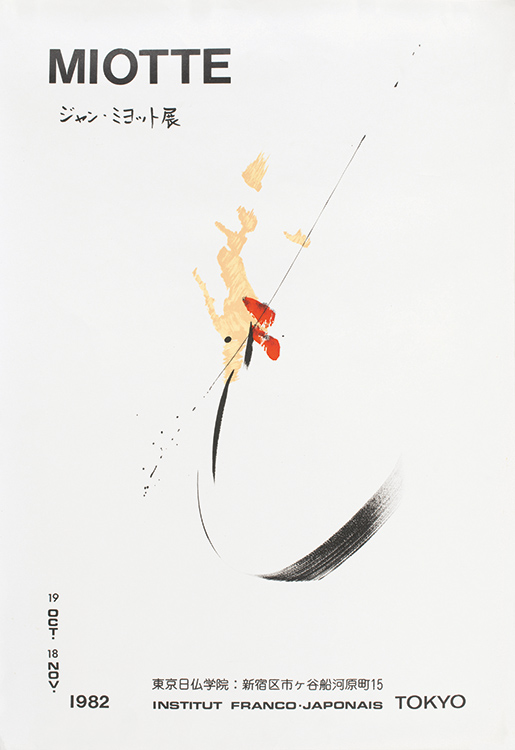
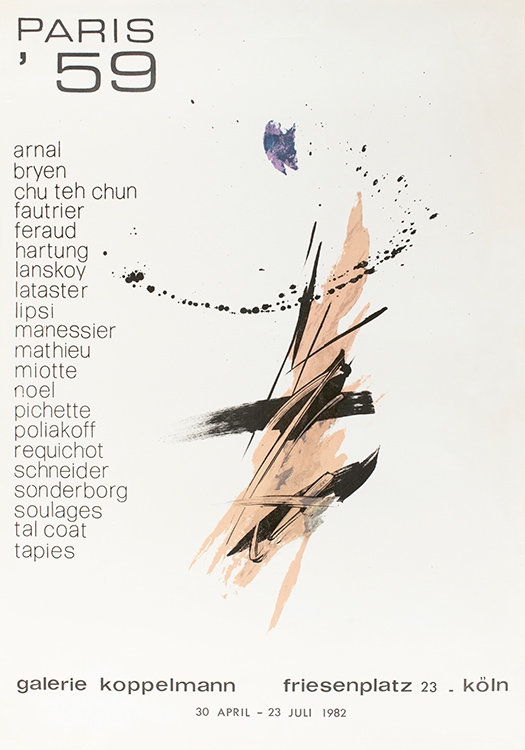
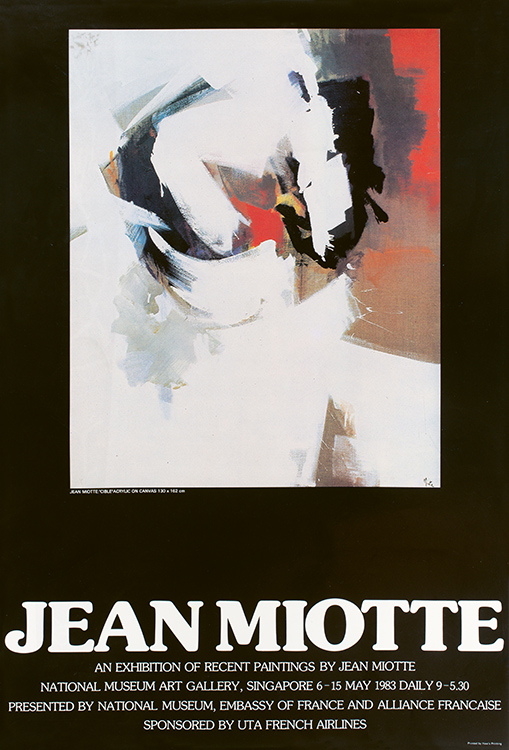
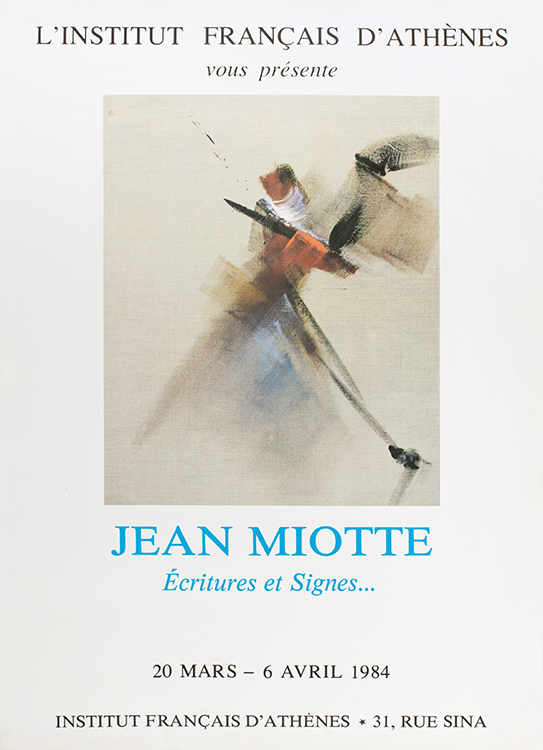
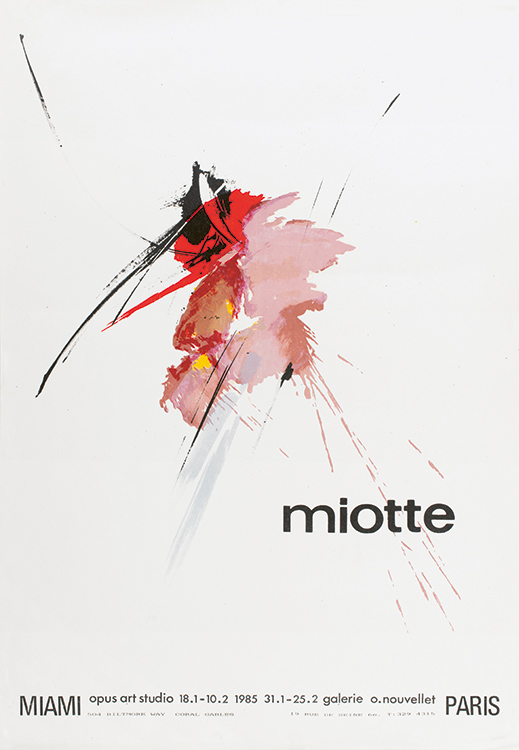
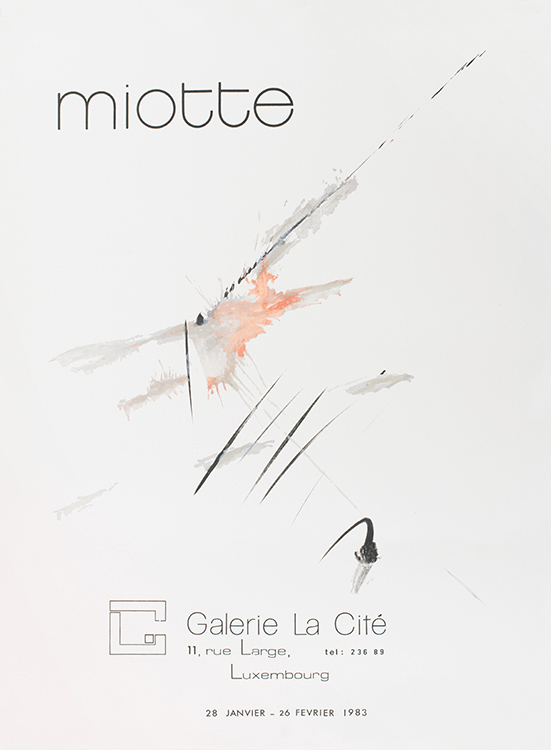
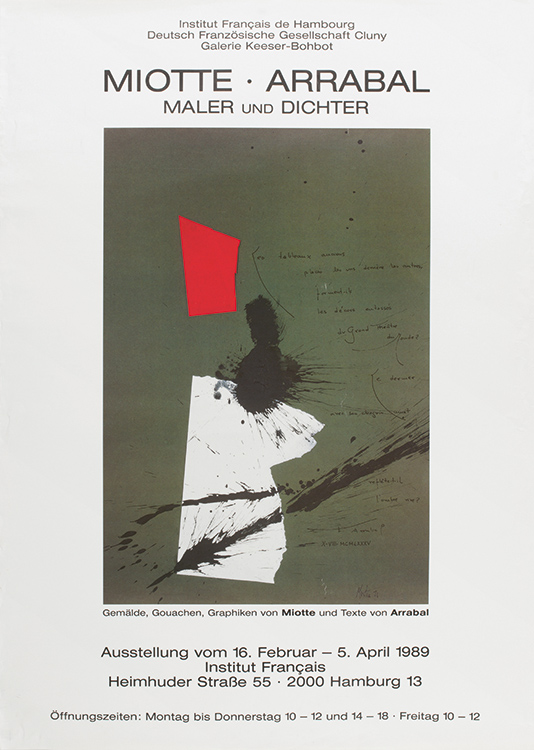
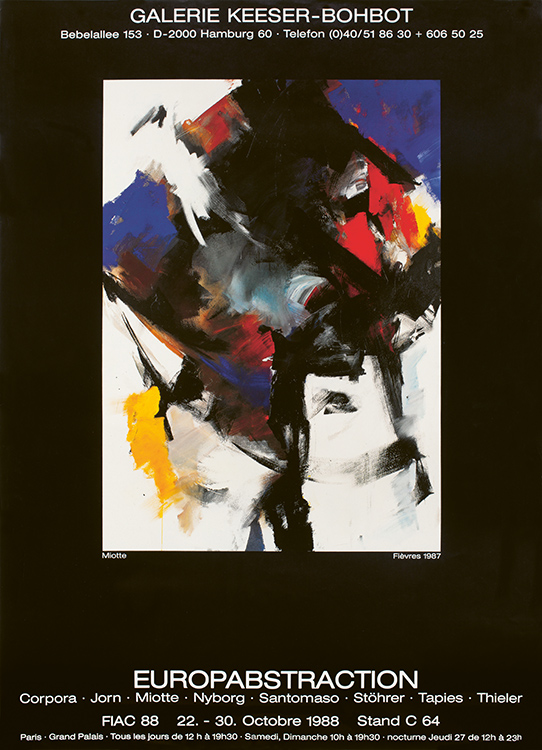
JEAN MIOTTE
L’invitation au voyage
Exhibition from March 6 to April 19, 2025
Diane de Polignac Gallery
2 bis, rue de Gribeauval, Paris
www.dianedepolignac.com
Translation: Lucy Johnston
Graphic design: Diane de Polignac Gallery
ISBN:978-2-9584349-9-1
© Diane de Polignac Gallery, Paris, 2025
Texts are author’s property
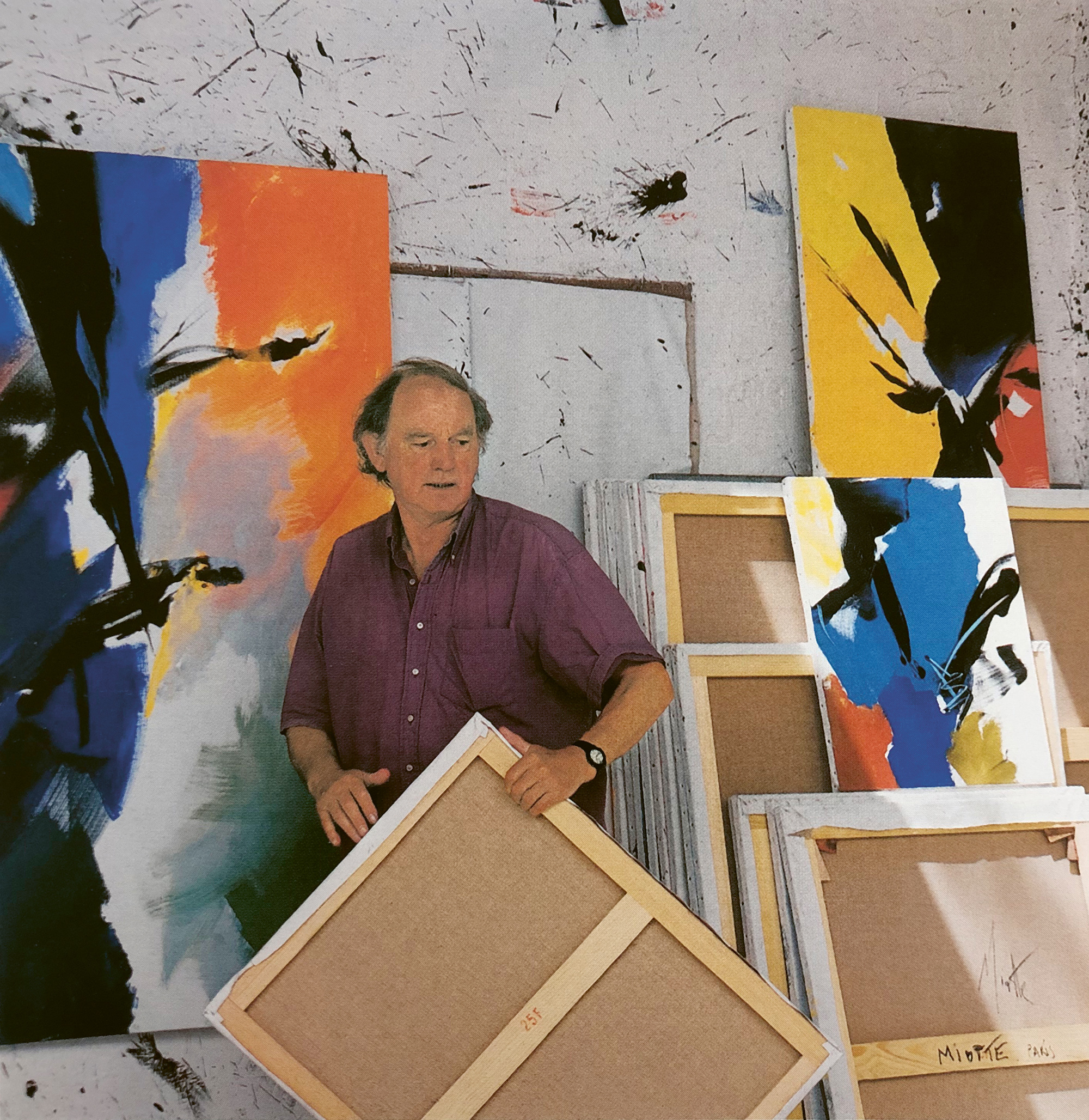
Jean Miotte in his studio, Pignans, France, 1985
